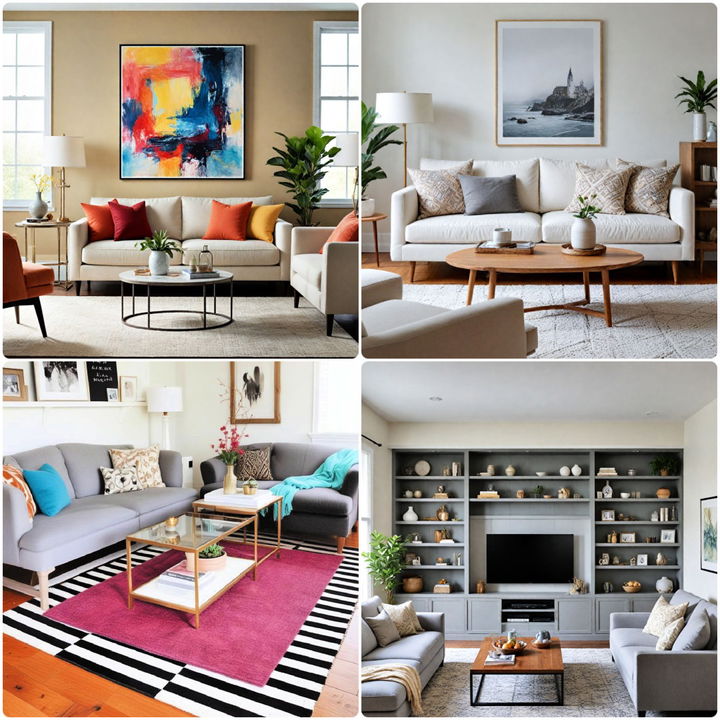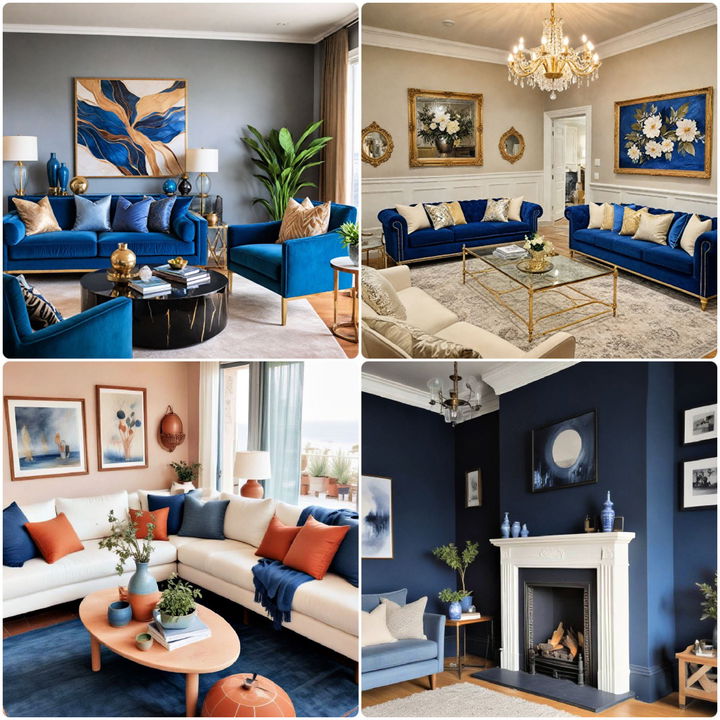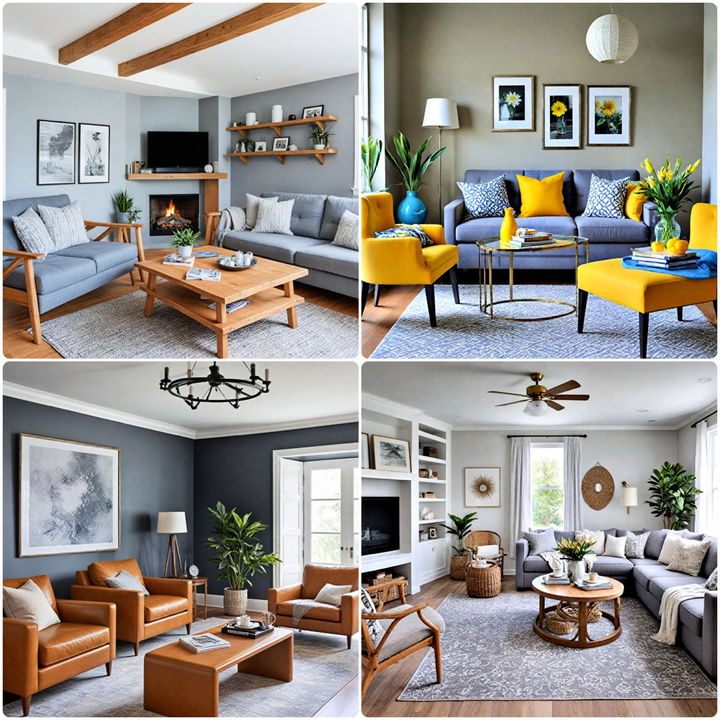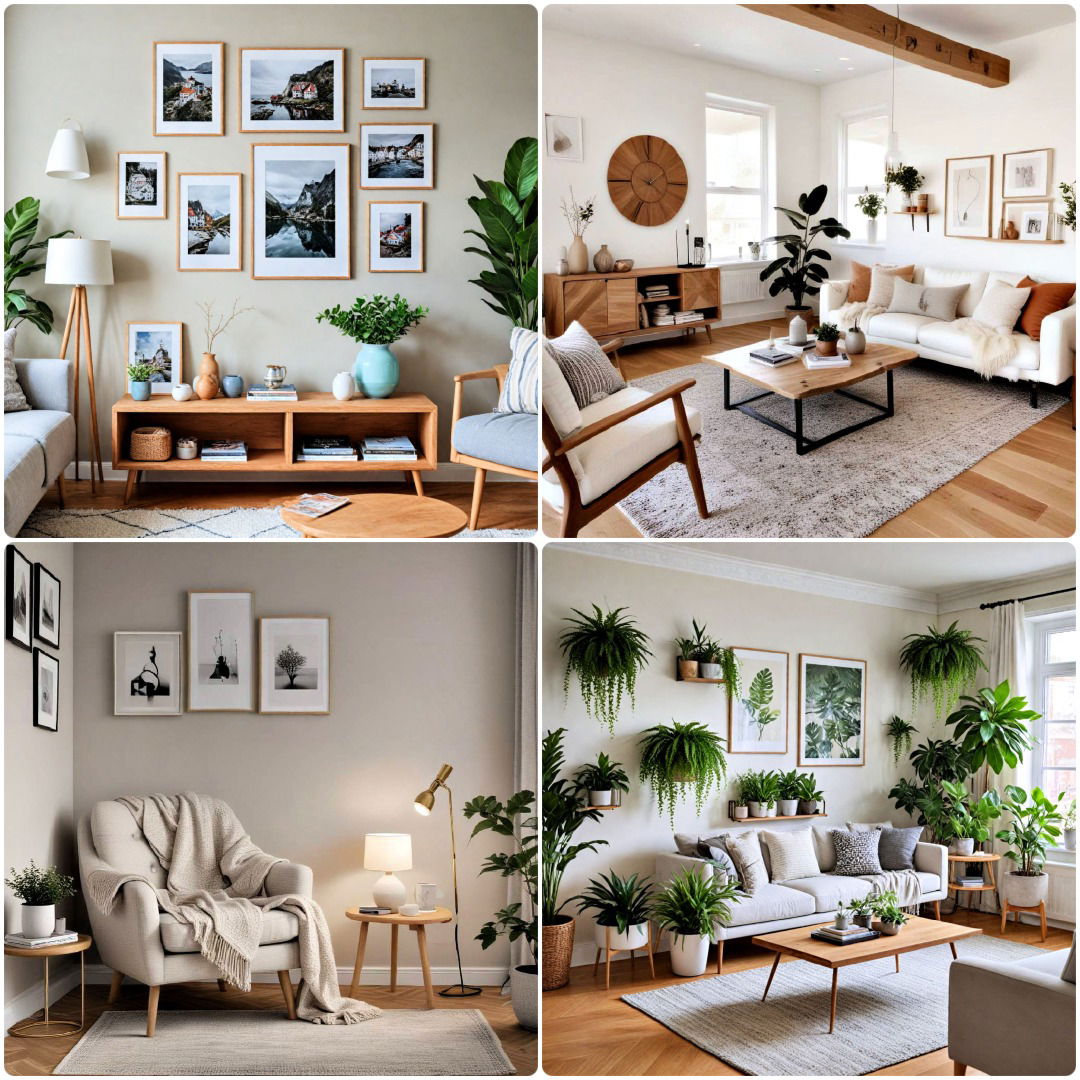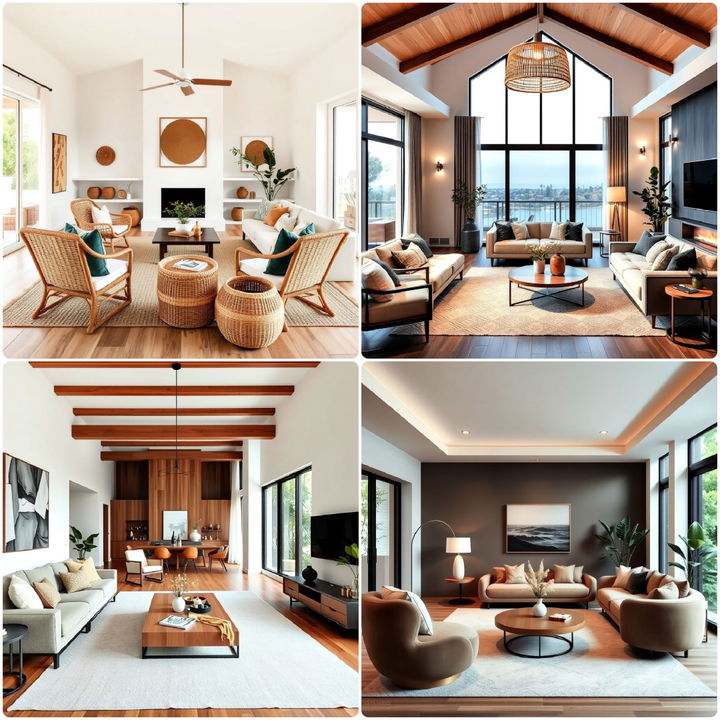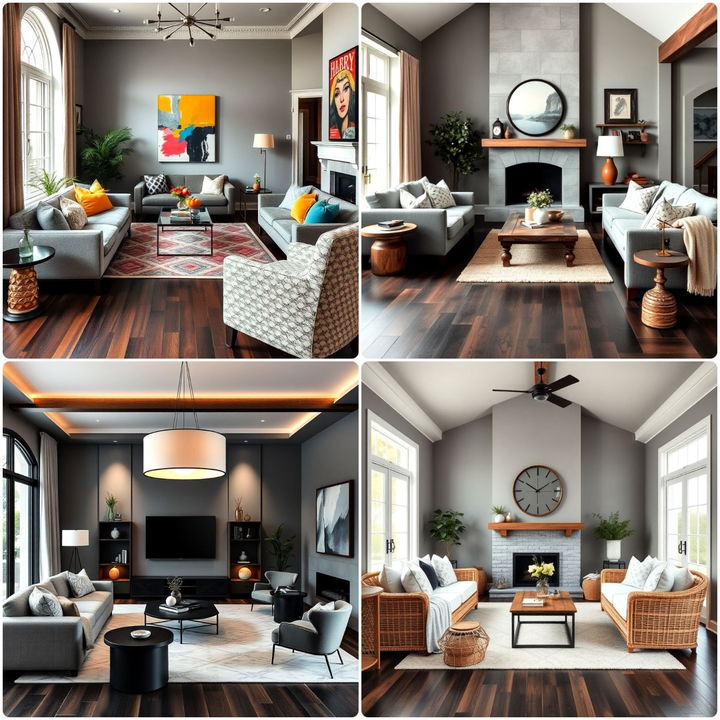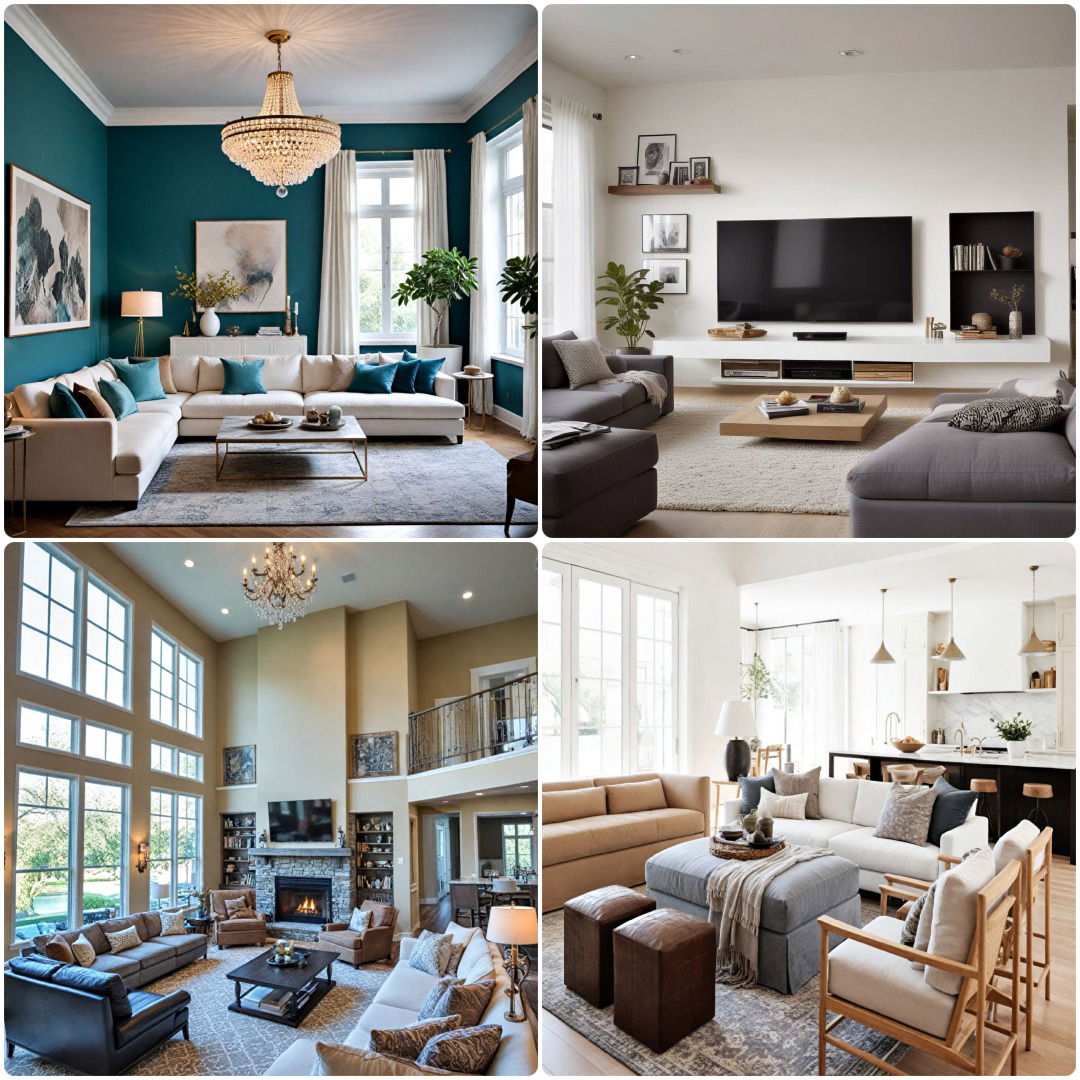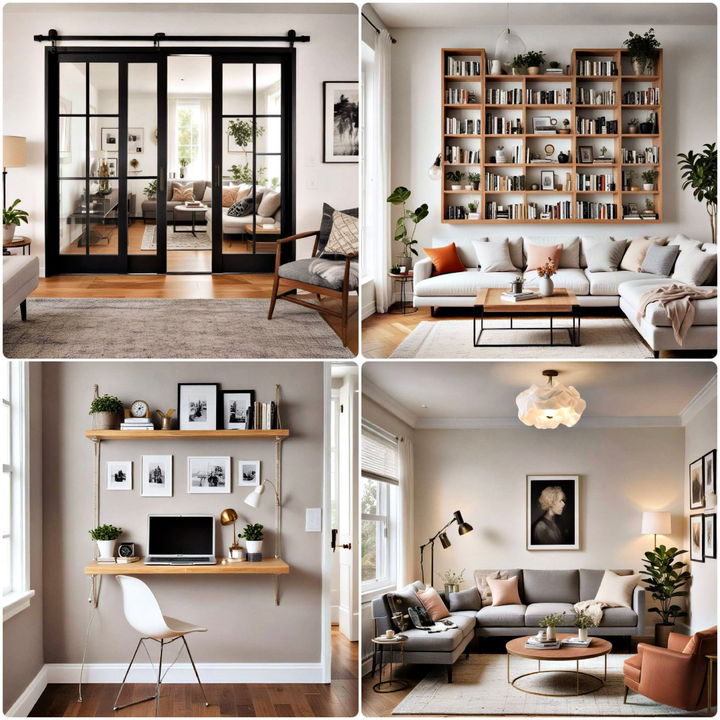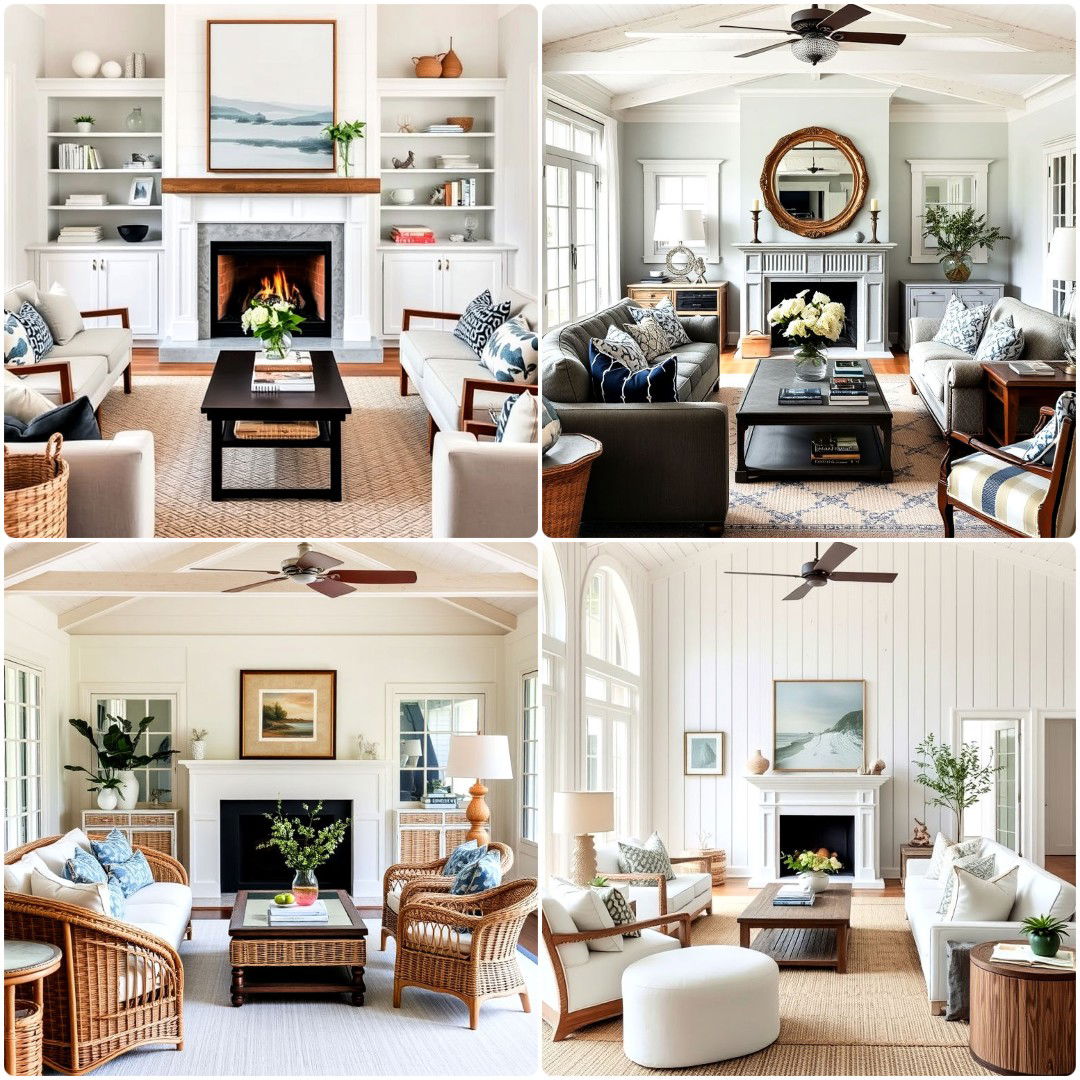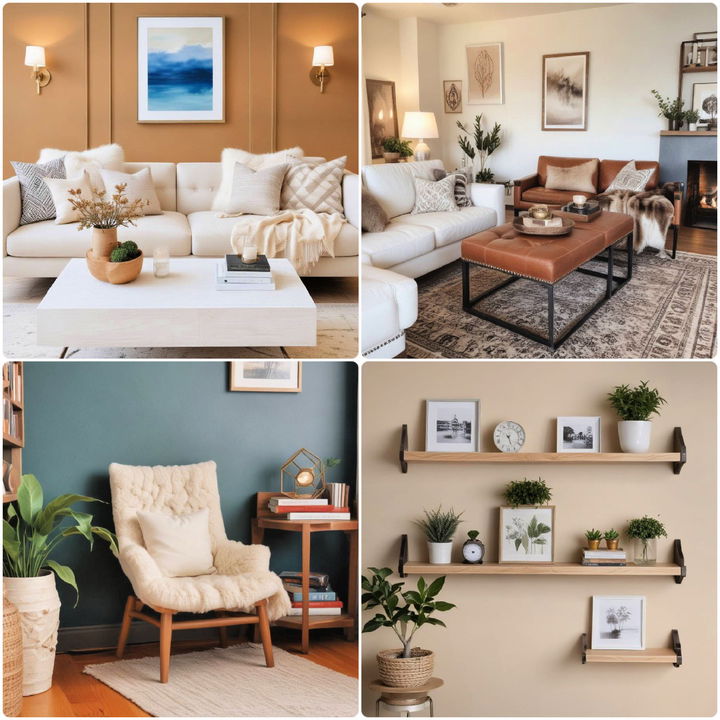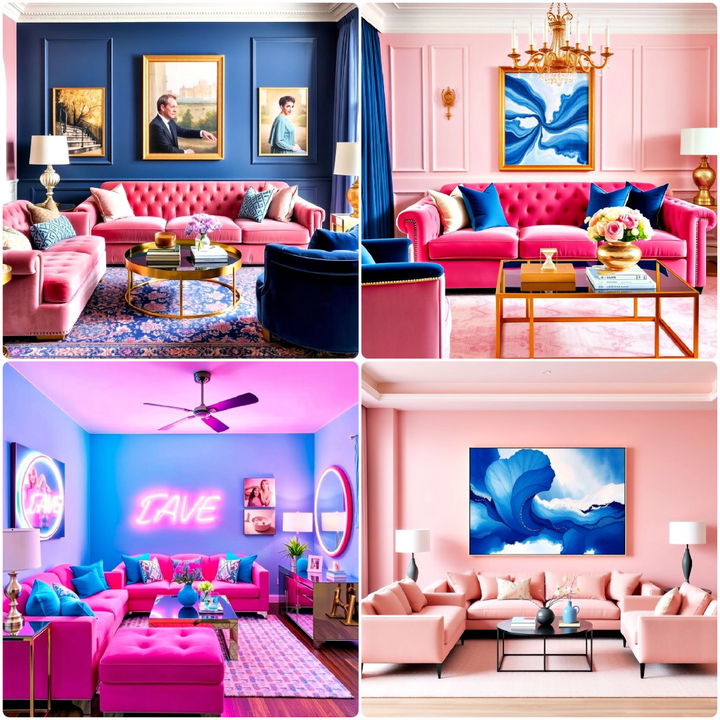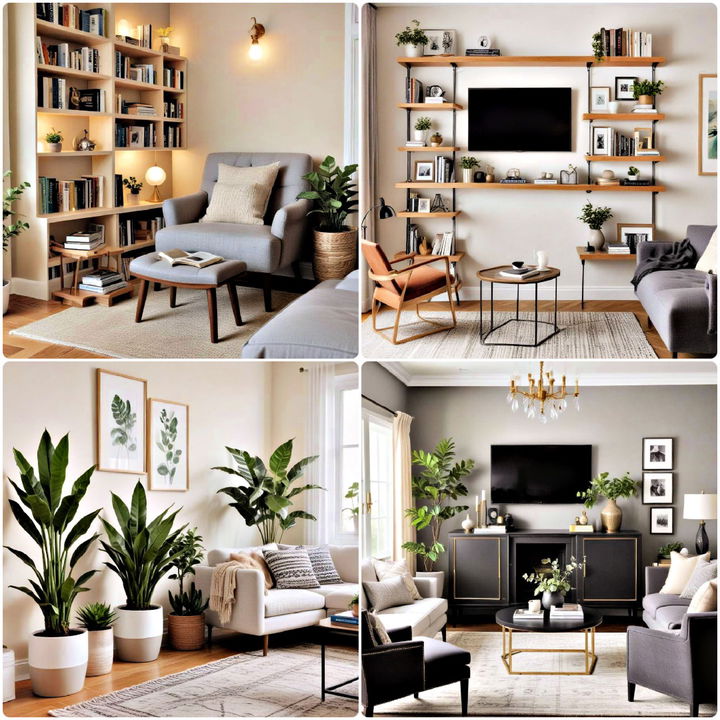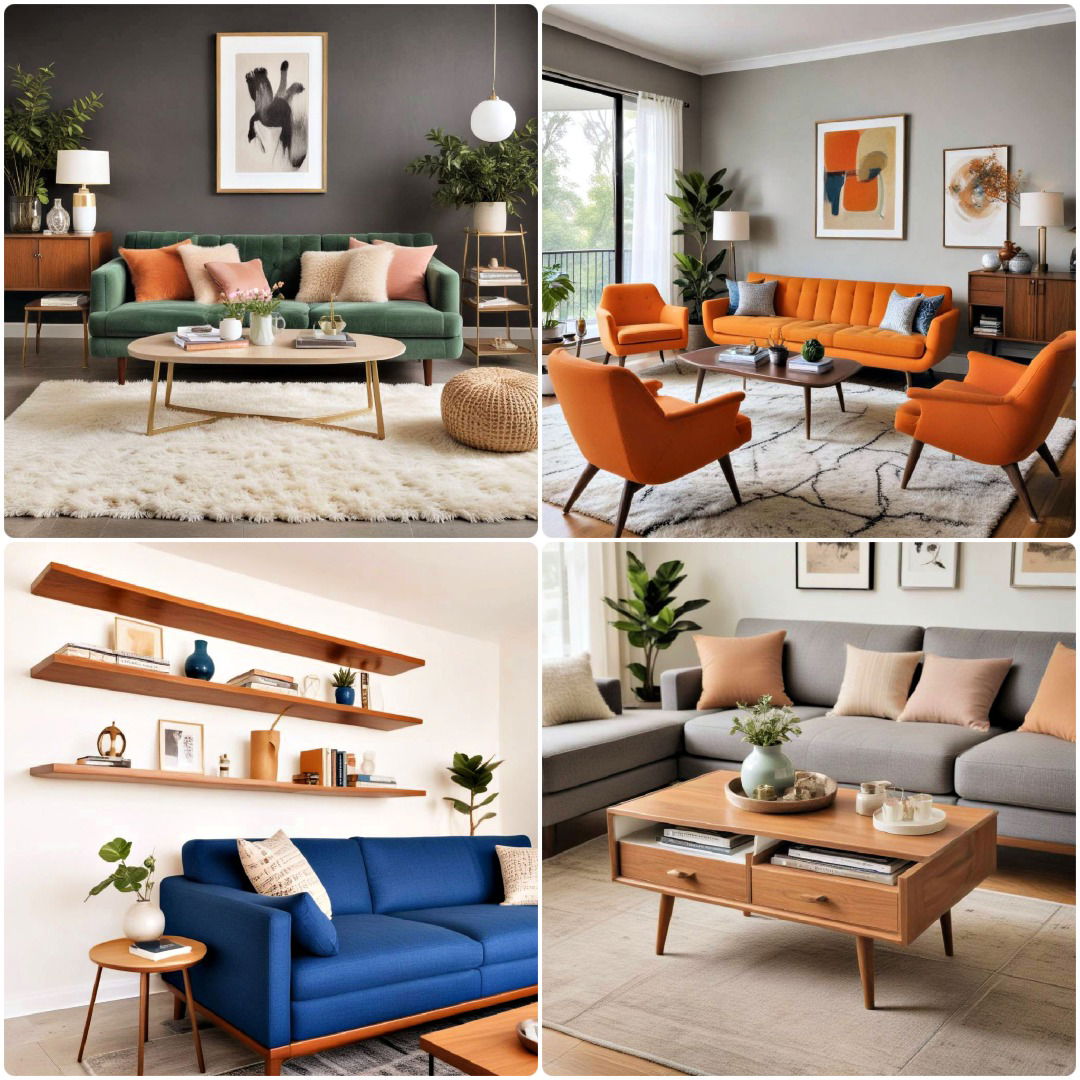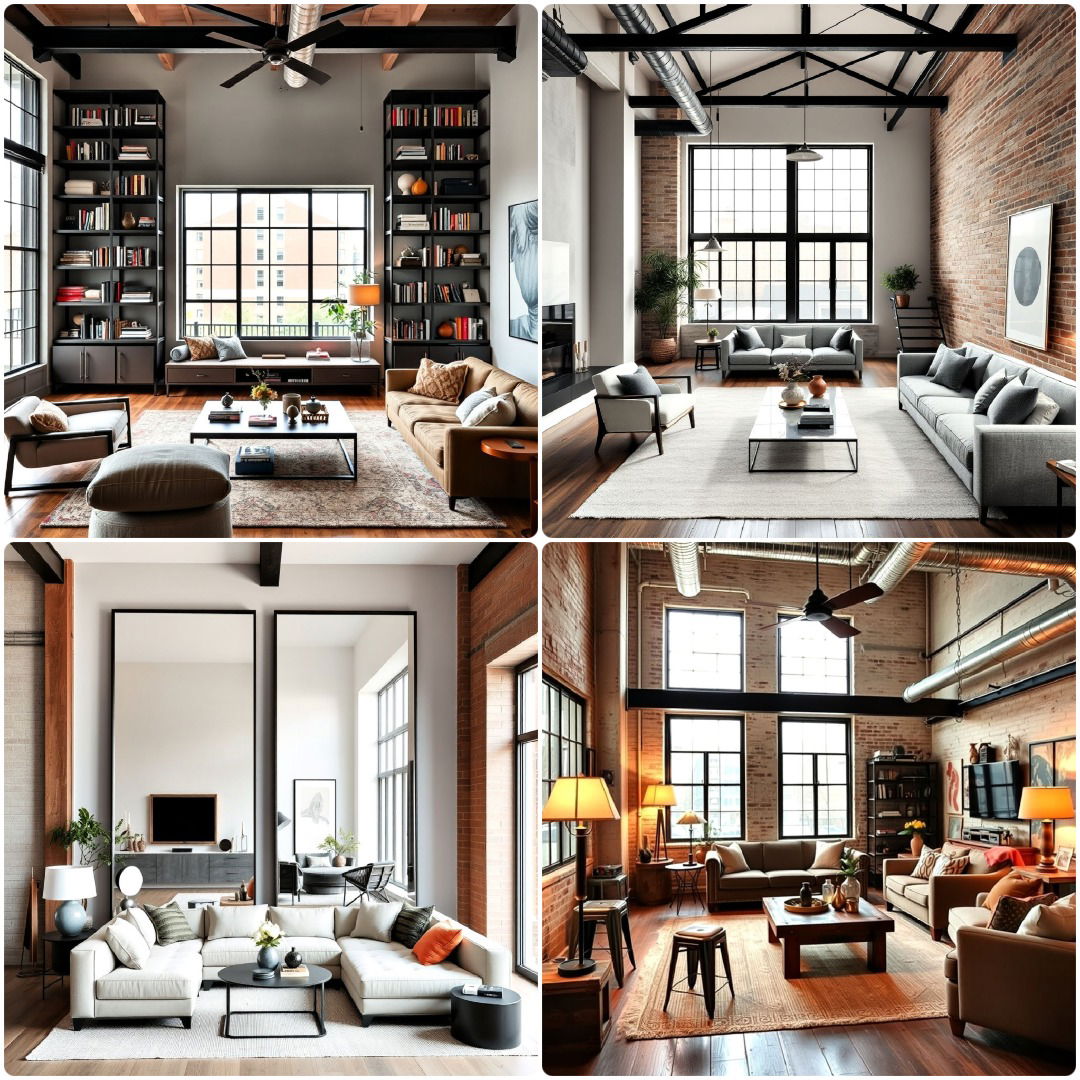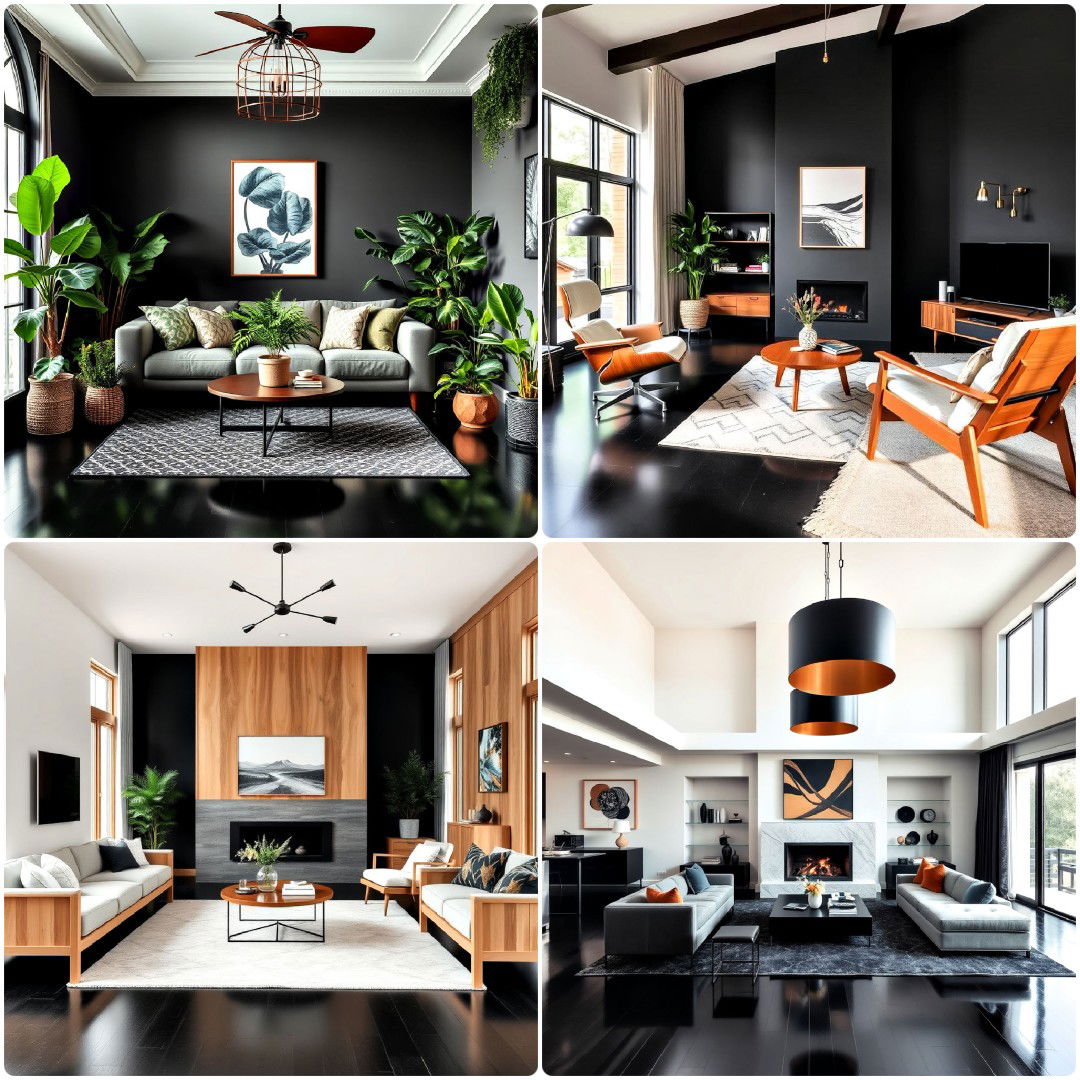A transitional living room strikes a balance between classic elegance and modern sophistication, blending the best of both worlds to create a space that feels warm, inviting, and endlessly stylish. By merging timeless elements with contemporary touches, transitional design offers endless possibilities for making your living room feel both luxurious and livable. Whether you're a fan of rich textures, bold accents, or clean lines, these 40 trendy transitional living room ideas will inspire you to transform your space into a haven of comfort and refined beauty.
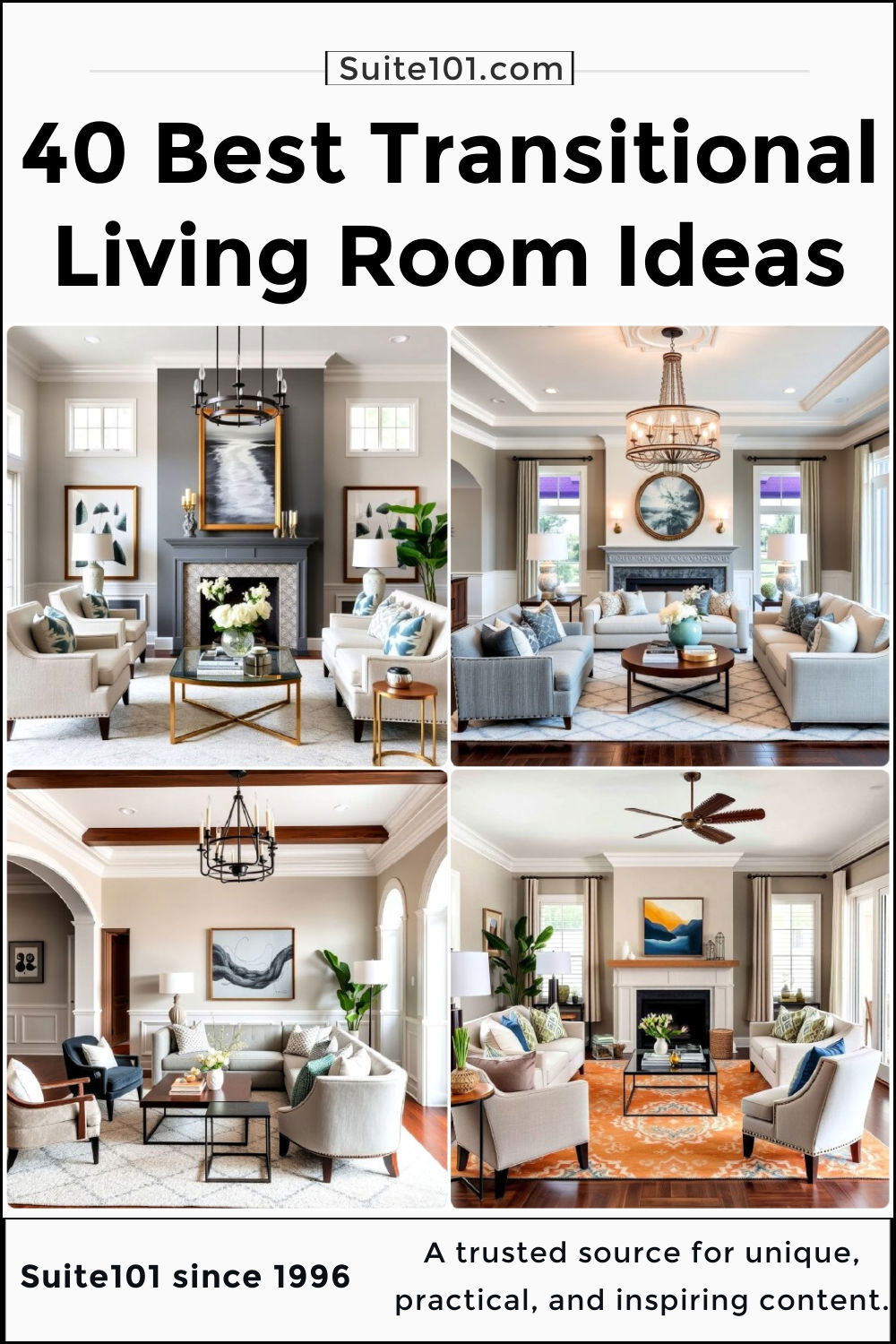
1. Blend Neutral Tones with Bold Accents
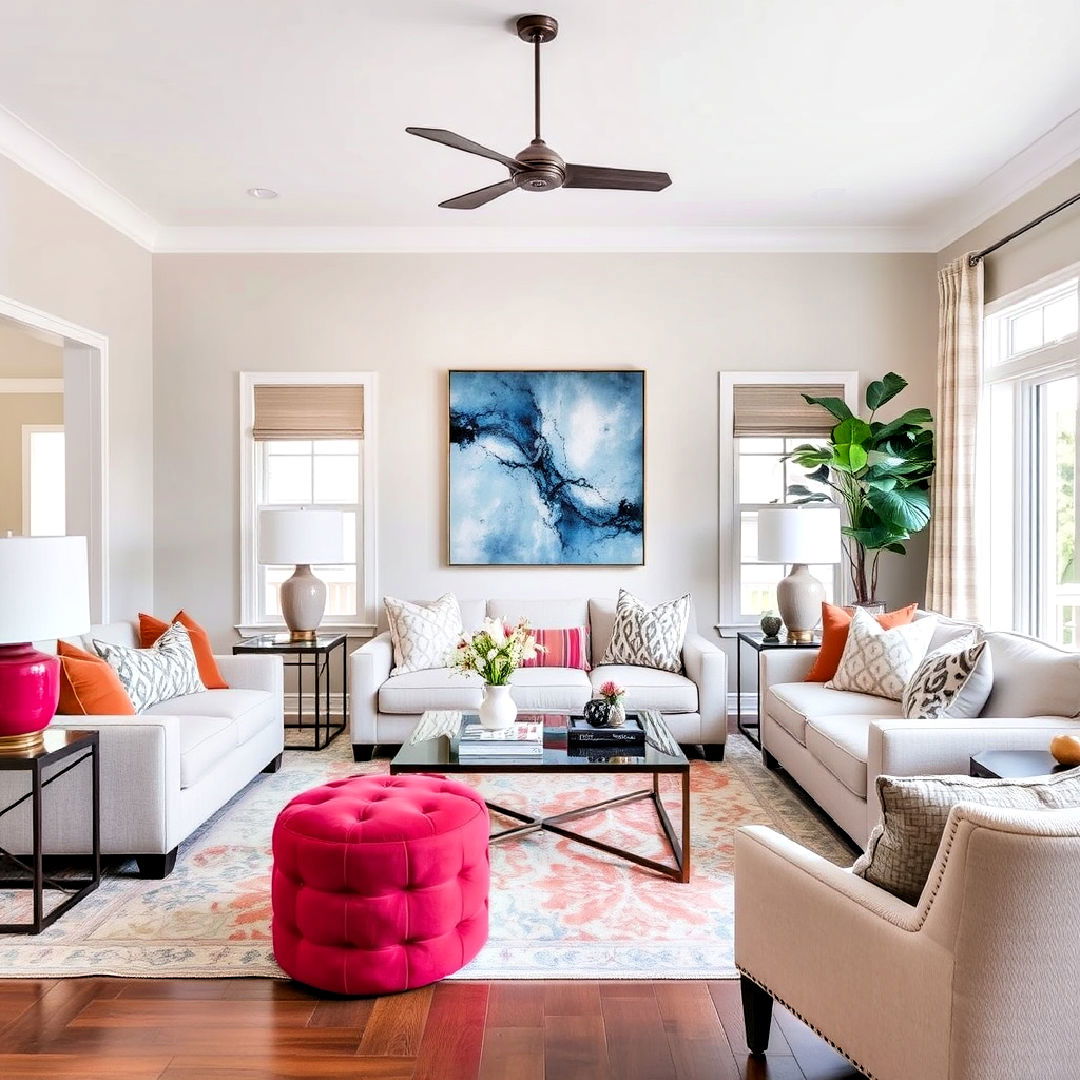
A transitional living room thrives on a neutral palette, such as soft grays, beiges, or whites, which creates a calming backdrop. To add personality, introduce bold accent colors through pillows, rugs, or artwork. This subtle mix of base tones and vibrant accents ensures a sophisticated look while keeping the room dynamic and lively without overwhelming the space.
2. Combine Modern and Traditional Furniture Styles
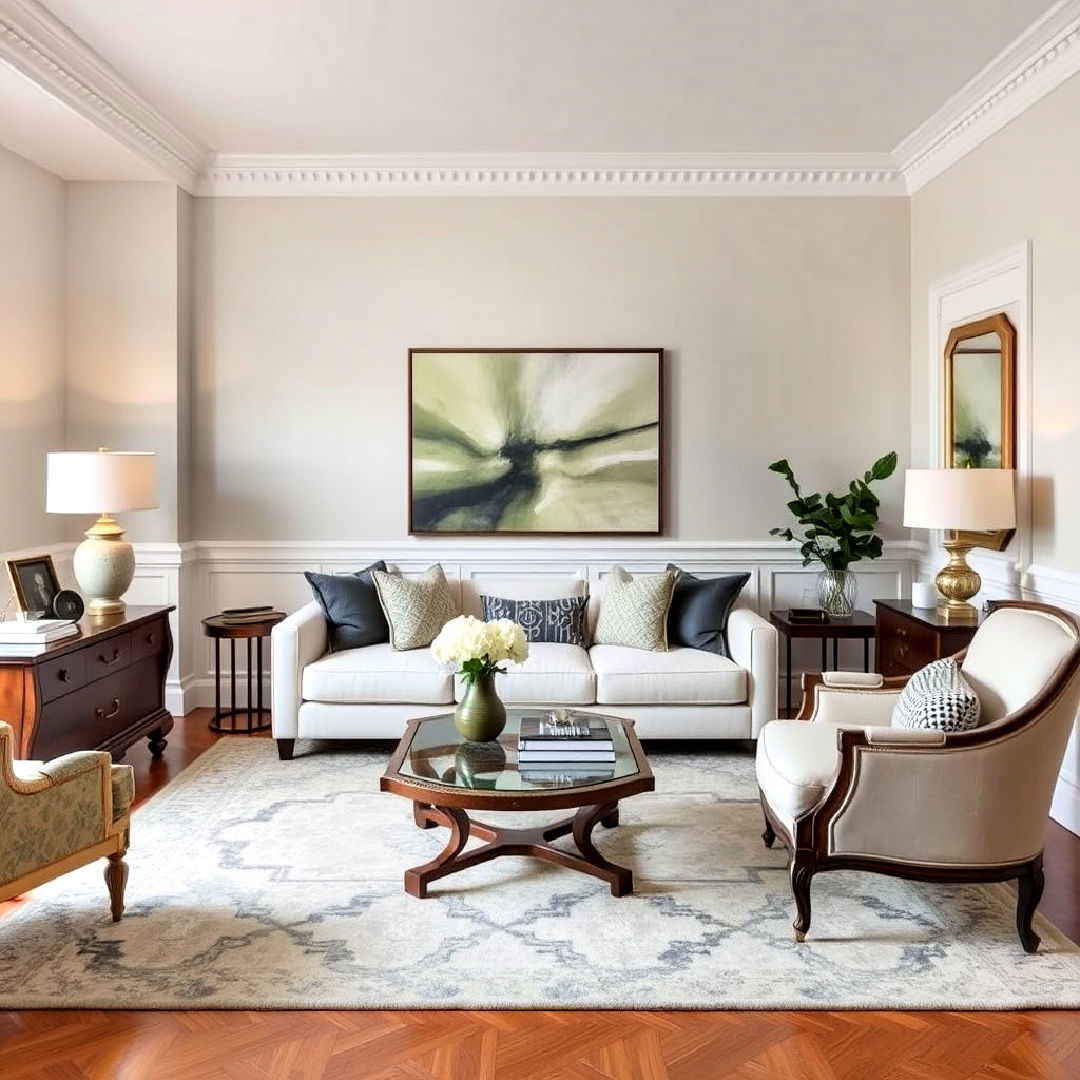
Incorporating both contemporary and classic furniture pieces creates a seamless fusion of styles. Pair a sleek, modern sofa with an ornate coffee table or a vintage armchair. The juxtaposition of these elements offers a balanced aesthetic, blending the best of both worlds to create a timeless yet fresh living room design.
3. Use Textured Fabrics for Depth
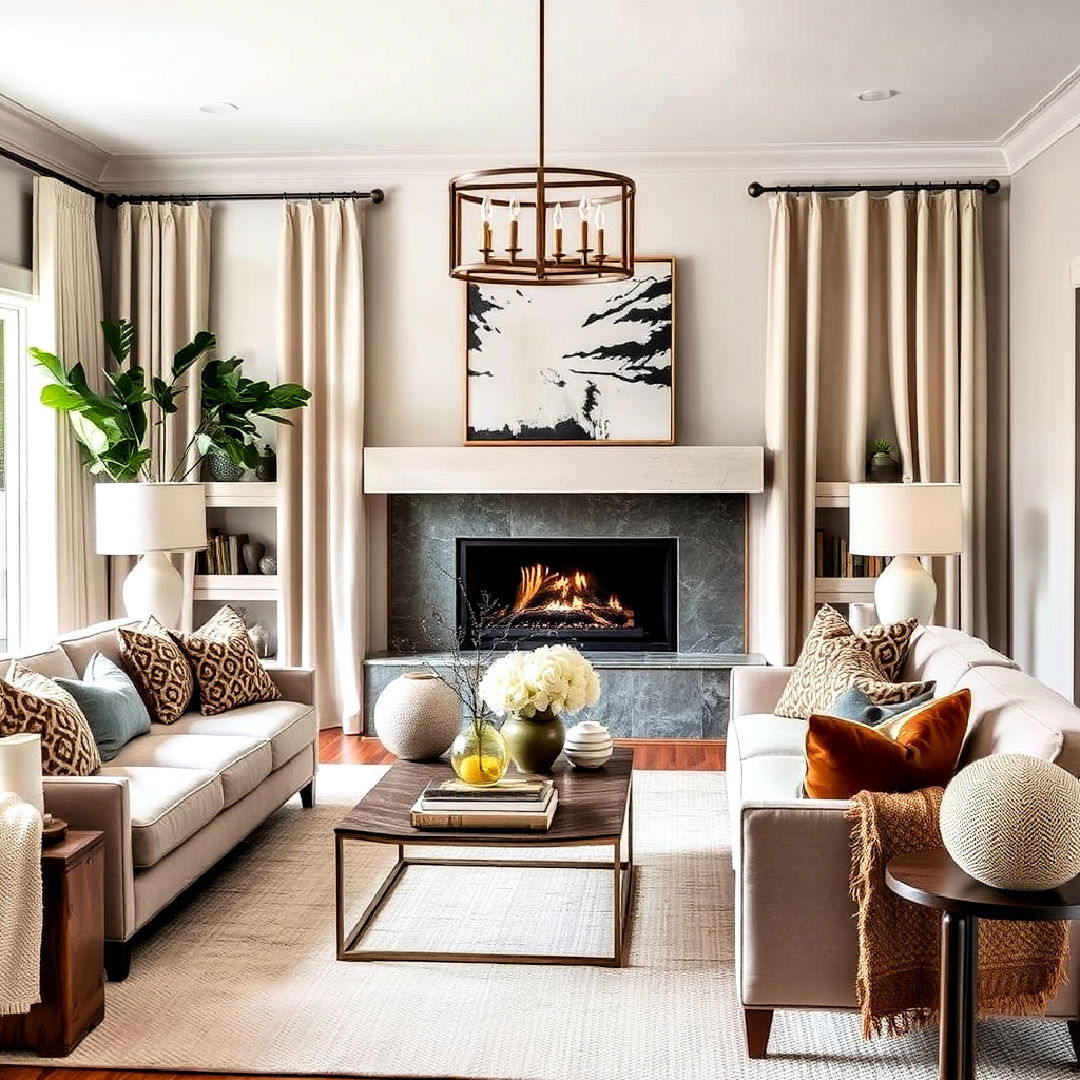
Explore versatile transitional living room ideas that blend traditional and modern styles seamlessly. Introduce texture to a transitional living room through varied fabric choices. Velvet cushions, linen curtains, or wool throws can add visual interest and tactile warmth. The mix of different textures in neutral or complementary tones helps create a layered, inviting space that feels both cozy and refined.
4. Opt for Statement Lighting
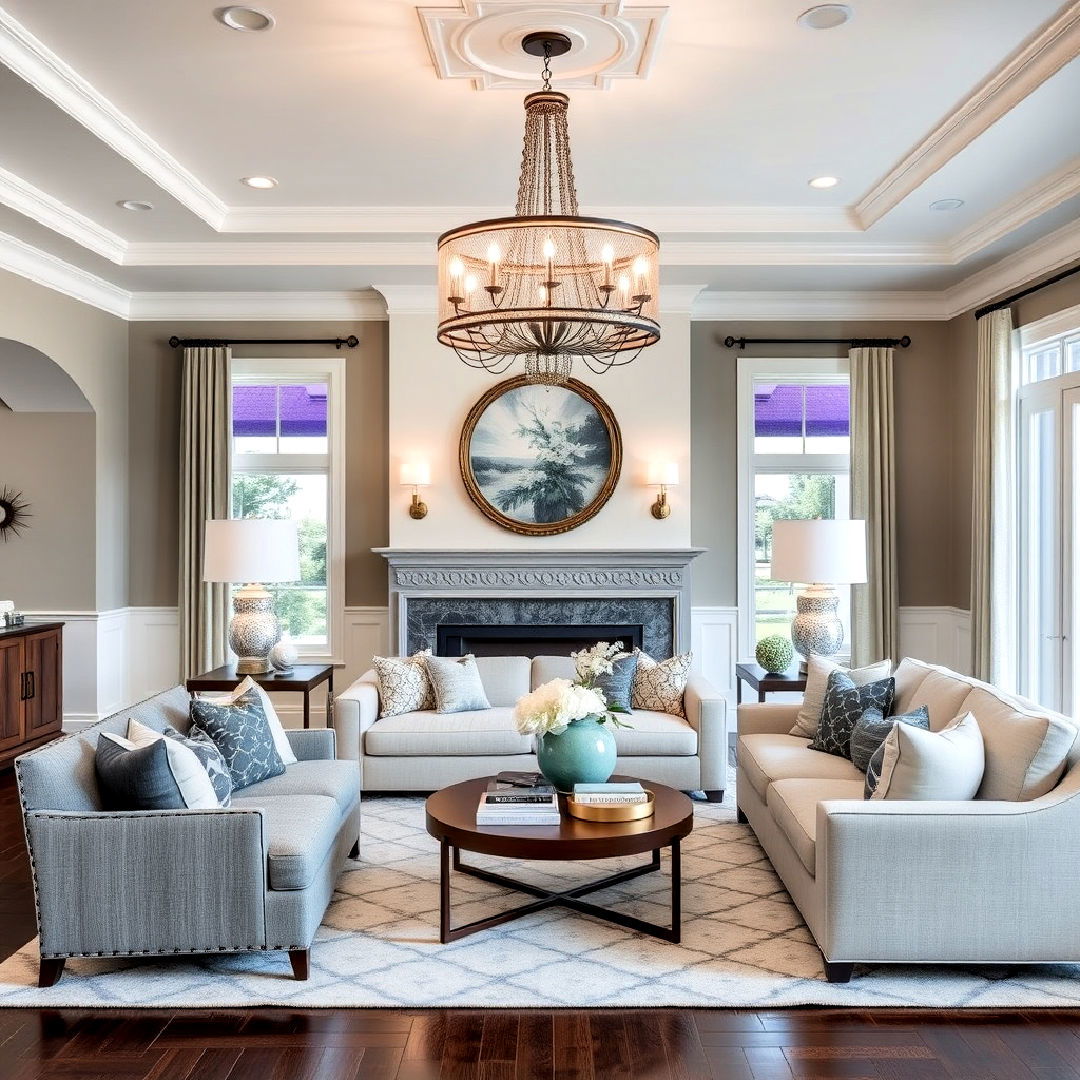
Statement lighting can elevate a transitional living room instantly. Consider adding an oversized chandelier or a pair of modern floor lamps with intricate detailing. The right lighting fixtures not only serve as functional elements but also double as artistic focal points, balancing the room’s mix of classic and modern influences.
5. Incorporate Clean Lines and Curved Edges
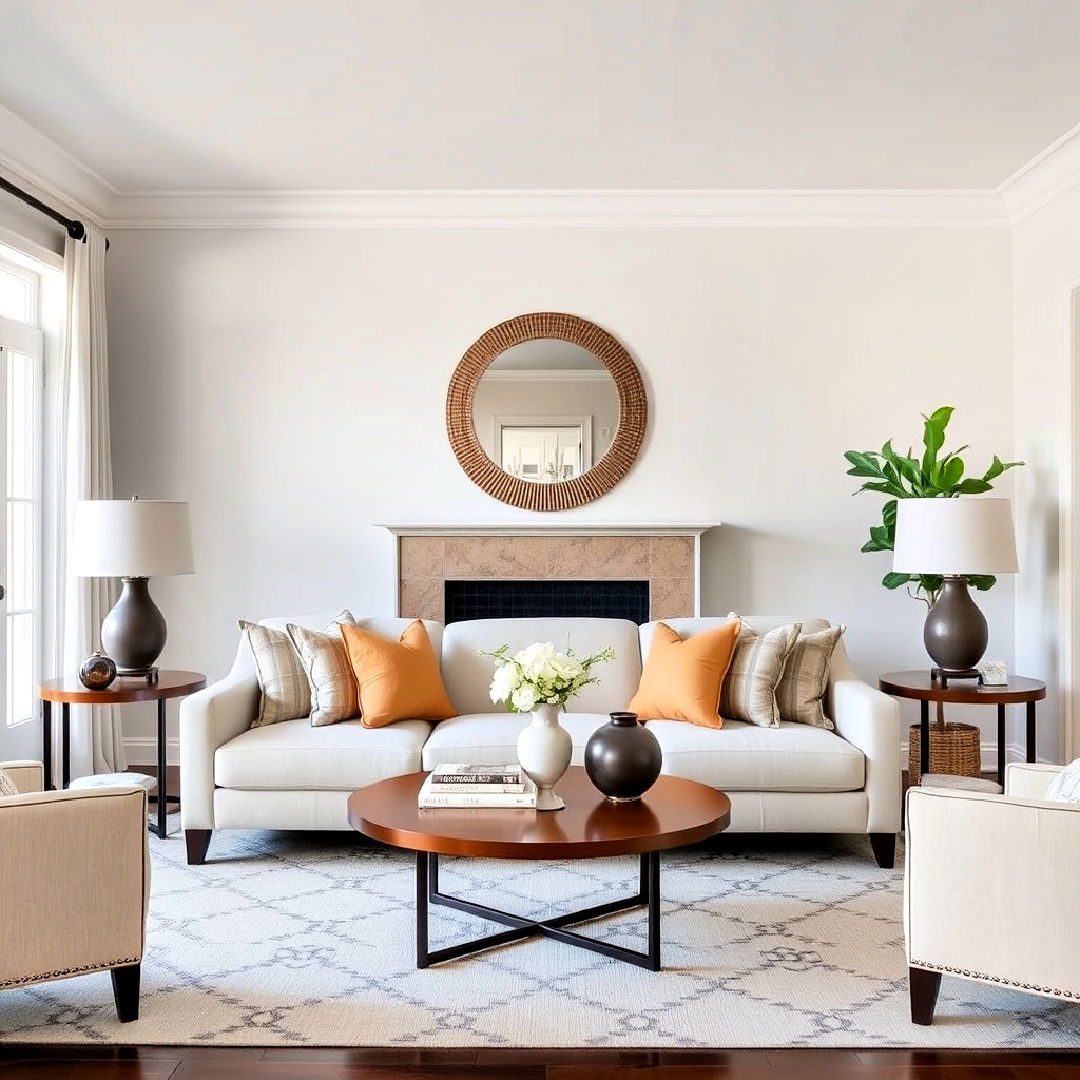
To maintain the balance between traditional and contemporary styles, mix clean, sharp lines with softer, curved edges. A streamlined sofa paired with round side tables or a circular mirror can help soften the overall look. This approach adds an elegant fluidity to the room while ensuring it remains sophisticated and approachable.
6. Mix Metal and Wood Accents
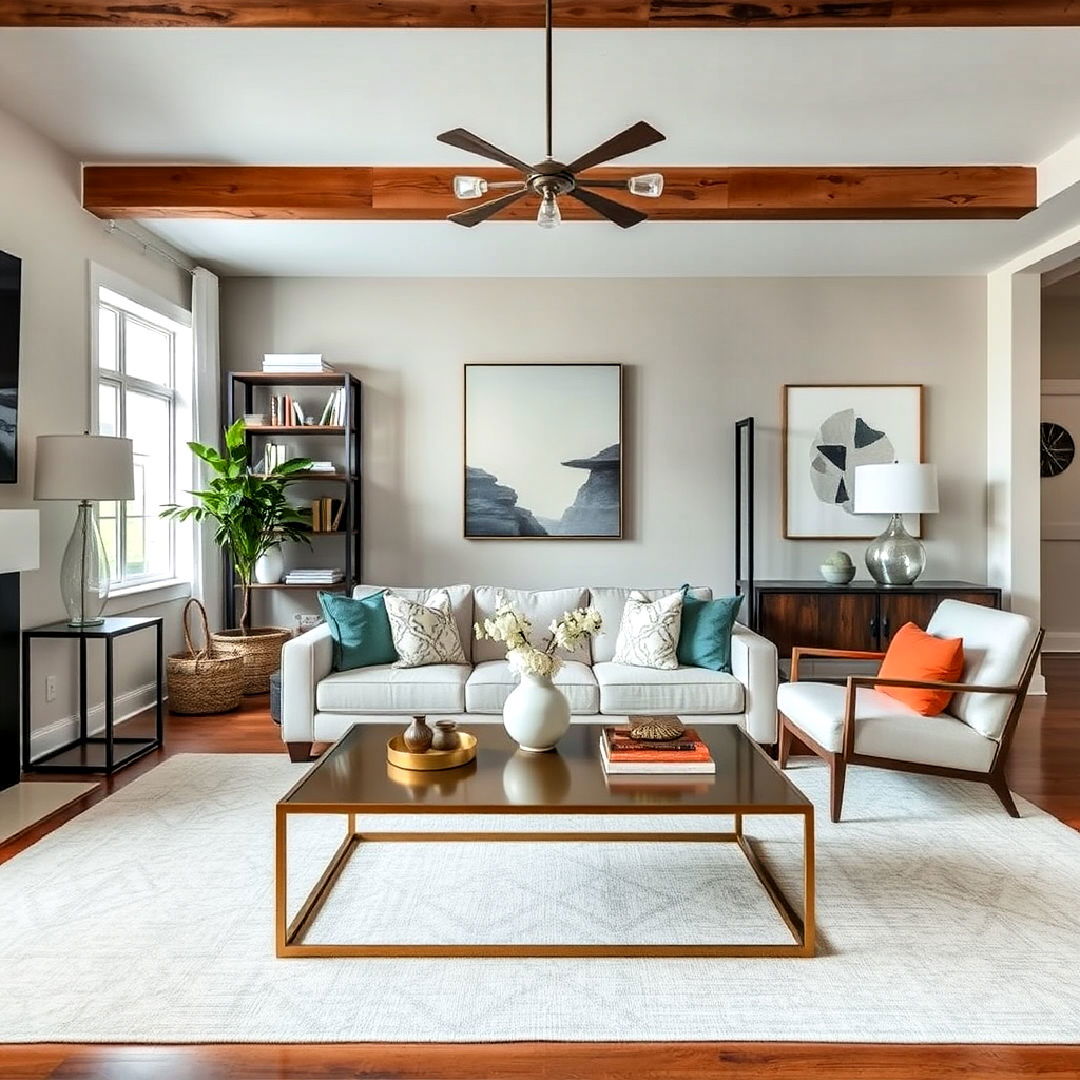
A transitional living room benefits from the contrast between metal and wood elements. For example, a sleek brass coffee table paired with a rustic wooden bookshelf introduces a perfect balance of industrial and natural materials. This mix adds warmth and character, enhancing the room's overall visual appeal while staying grounded in both modern and traditional design.
7. Layer Rugs for Added Dimension
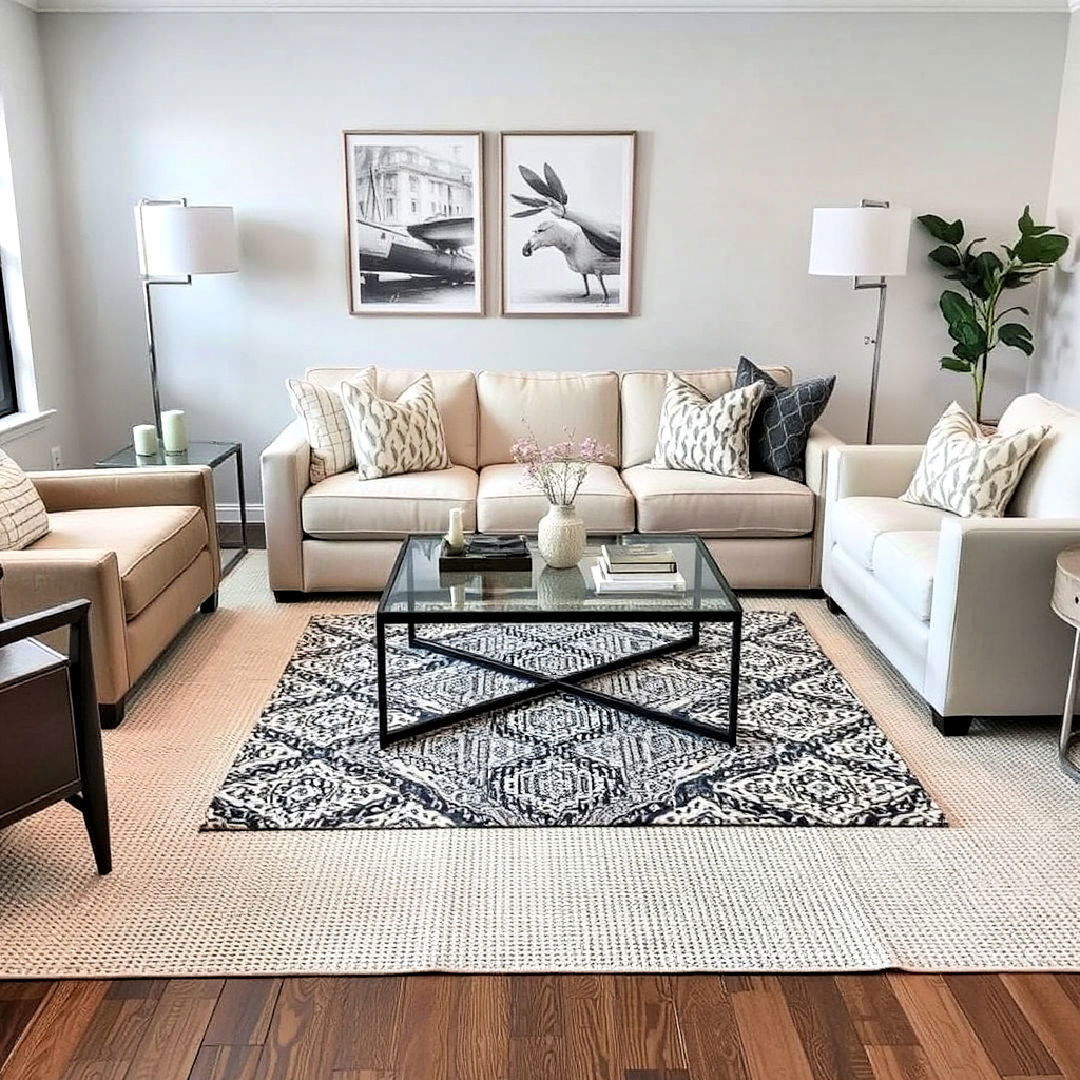
Layering rugs is a great way to introduce depth and texture into a transitional living room. Start with a large neutral rug as a base, and then add a smaller patterned or textured rug on top. This combination creates a cozy yet sophisticated atmosphere, offering a subtle yet stylish visual contrast that suits transitional decor.
8. Choose Monochromatic Artwork
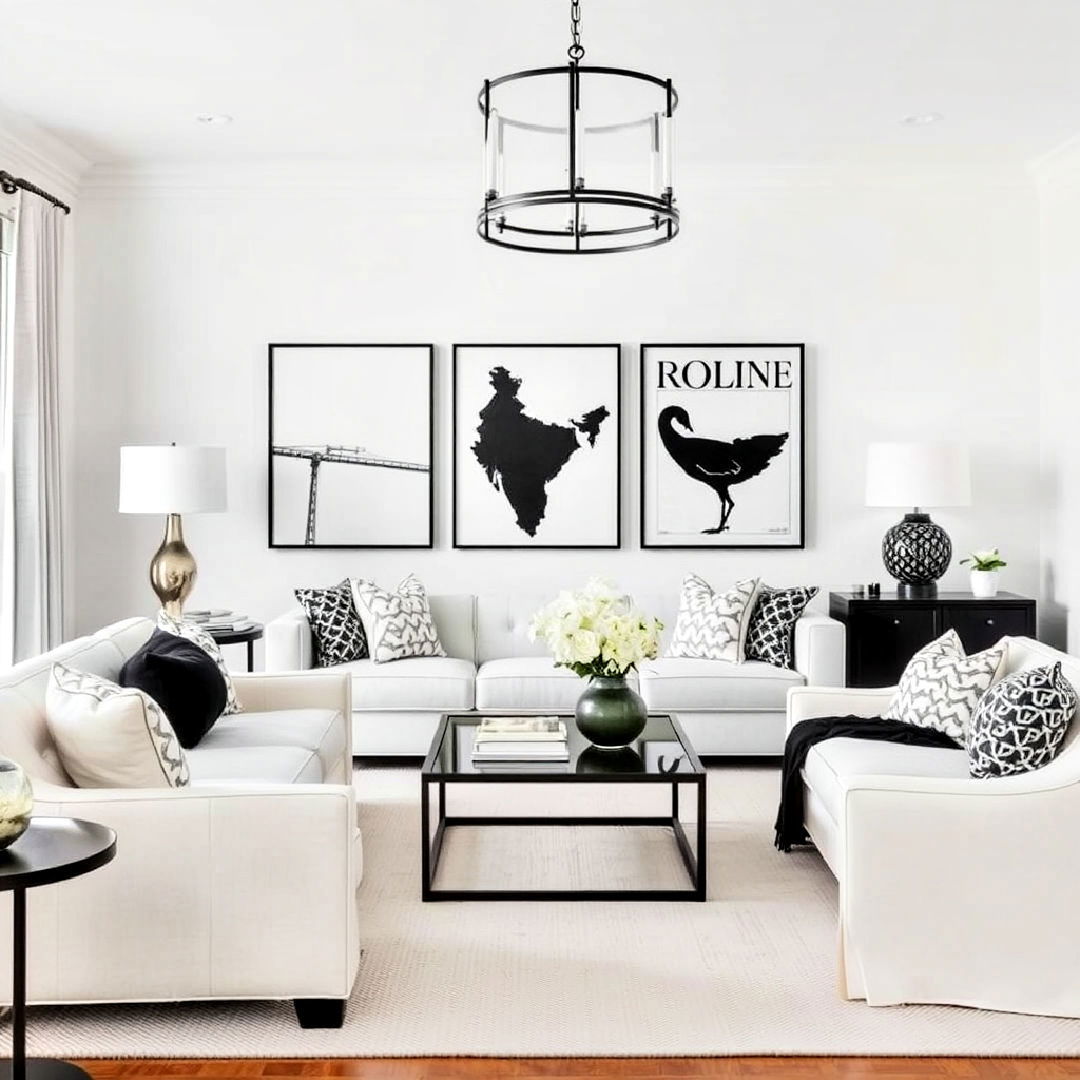
Create a harmonious space with a transitional-style living room that offers both comfort and elegance. Incorporating monochromatic artwork can enhance the elegance of a transitional living room without overpowering its clean design. Black-and-white photography, abstract prints, or tonal paintings complement neutral furnishings and help tie the space together. The simplicity of a monochromatic scheme aligns with the transitional style's understated sophistication.
9. Incorporate Symmetrical Design Elements
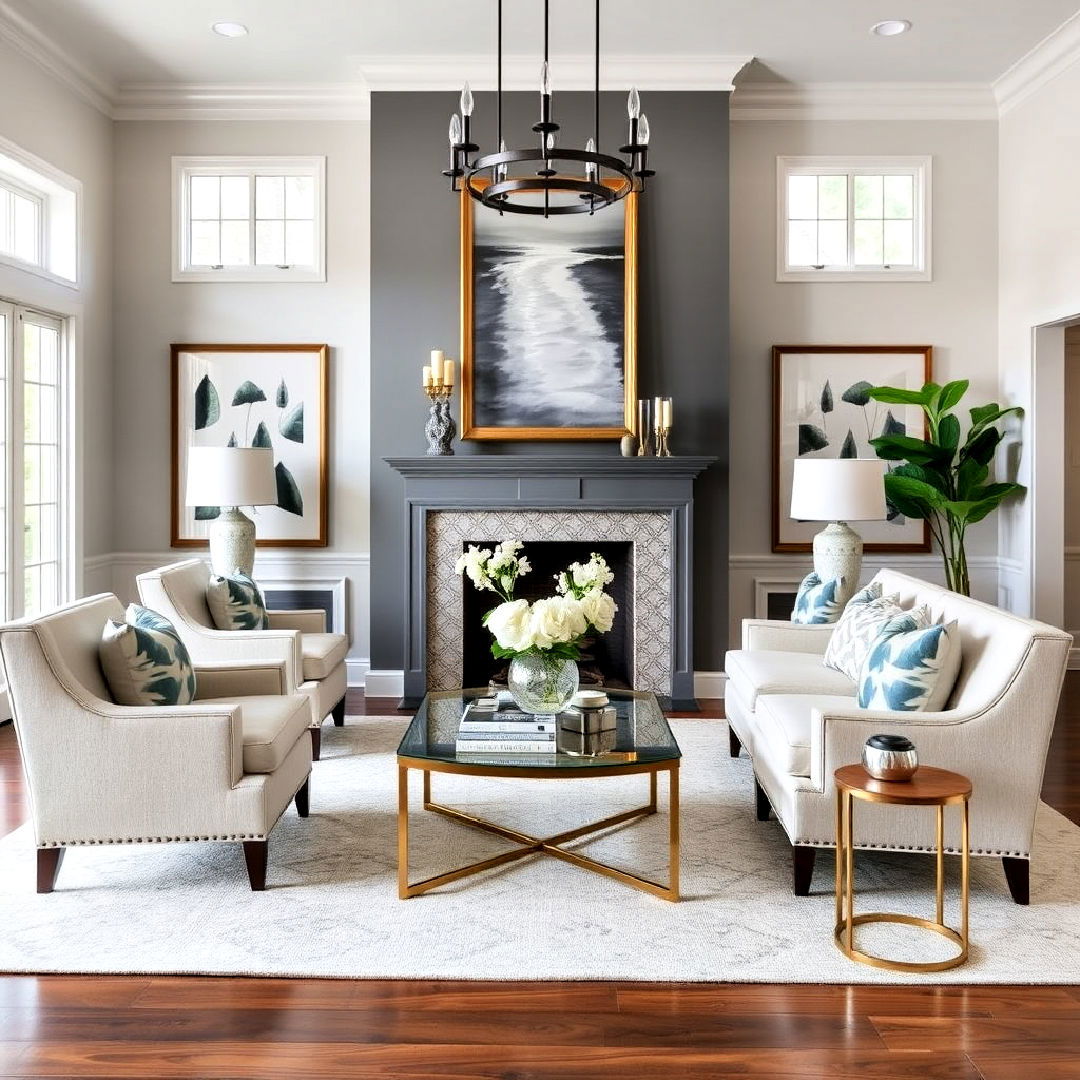
Symmetry is a hallmark of transitional living rooms, offering a sense of balance and order. Achieve this by placing identical armchairs on either side of the fireplace or by flanking a sofa with matching side tables and lamps. Symmetry creates visual harmony, which helps the room feel composed and serene without being overly formal.
10. Use Mirrored Furniture for a Luxe Touch
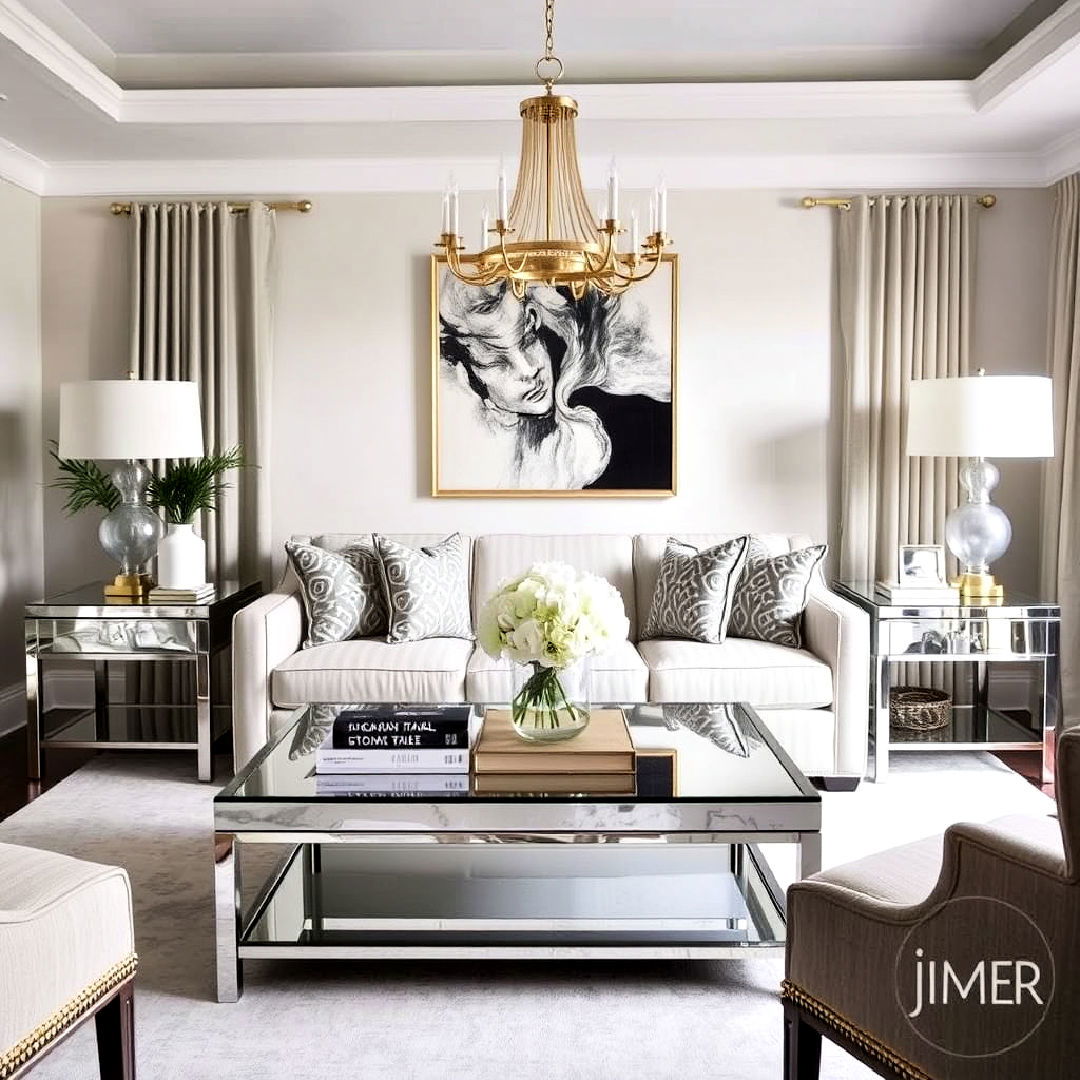
Mirrored furniture can add a glamorous yet subtle edge to a transitional living room. Consider incorporating a mirrored coffee table, console, or side tables to reflect light and make the space feel more open. These reflective surfaces blend effortlessly with neutral tones and enhance the room’s sophisticated ambiance without overshadowing its elegance.
11. Add a Statement Fireplace
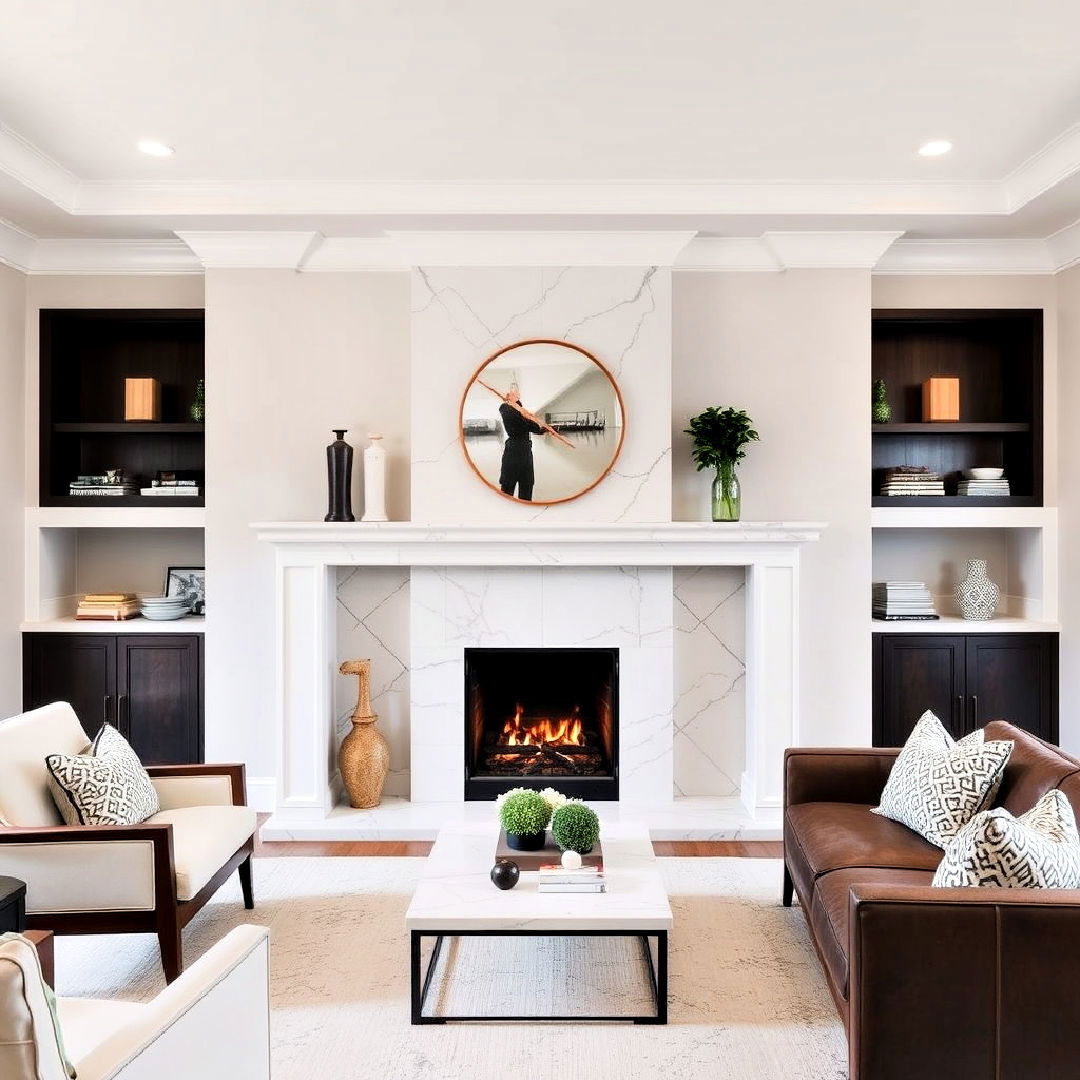
A fireplace can serve as the central focal point in a transitional living room. Opt for a sleek, modern design with traditional details, such as a marble mantel paired with contemporary tiles. The contrast between the materials creates a bold yet balanced feature that anchors the room and adds warmth both aesthetically and literally.
12. Incorporate Built-in Shelving
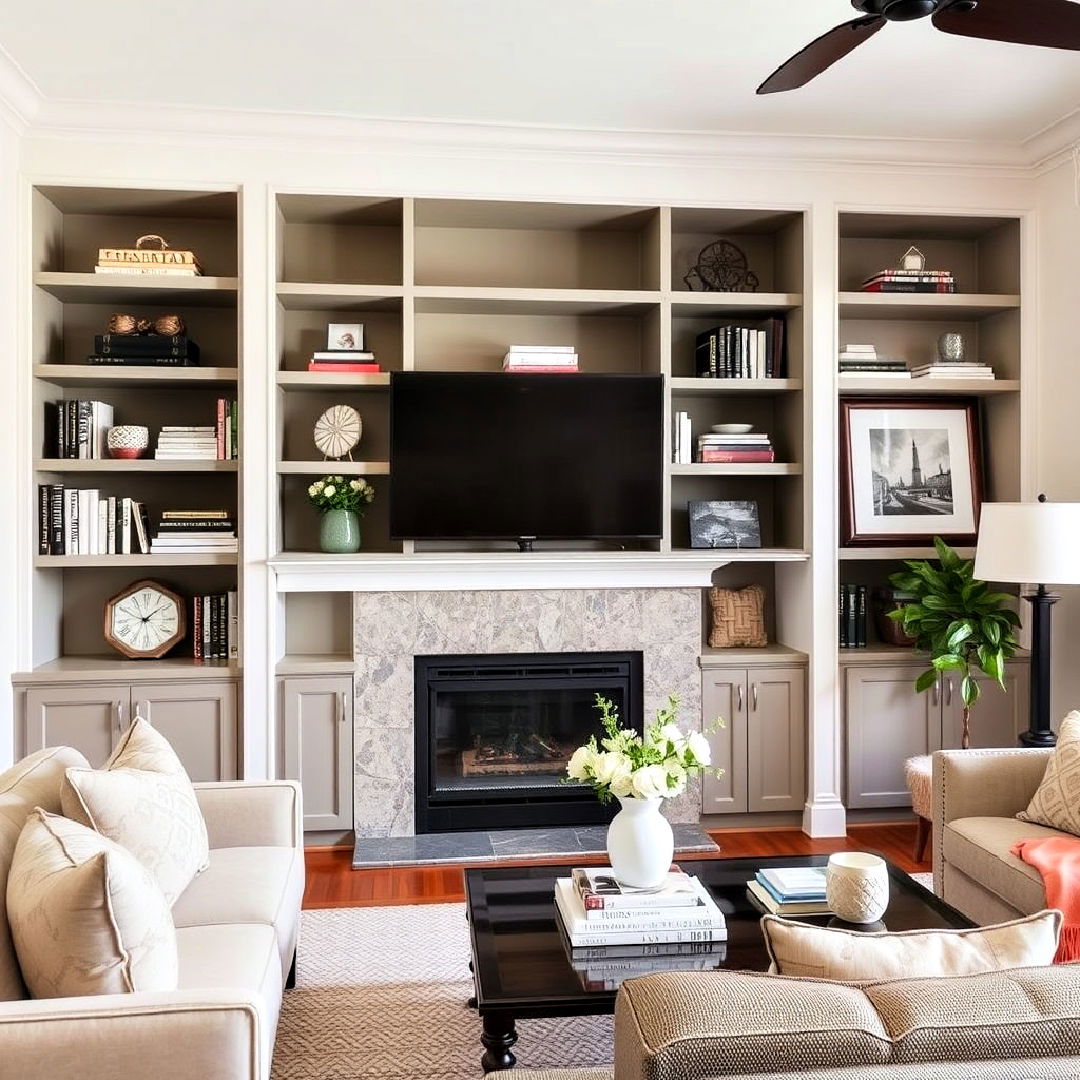
Built-in shelves not only add functional storage but also create a sophisticated, tailored look. Style them with a mix of books, decorative objects, and framed art to balance practicality with aesthetic appeal. This architectural feature enhances the room’s transitional design by blending traditional craftsmanship with modern organizational needs.
13. Use Soft, Layered Lighting
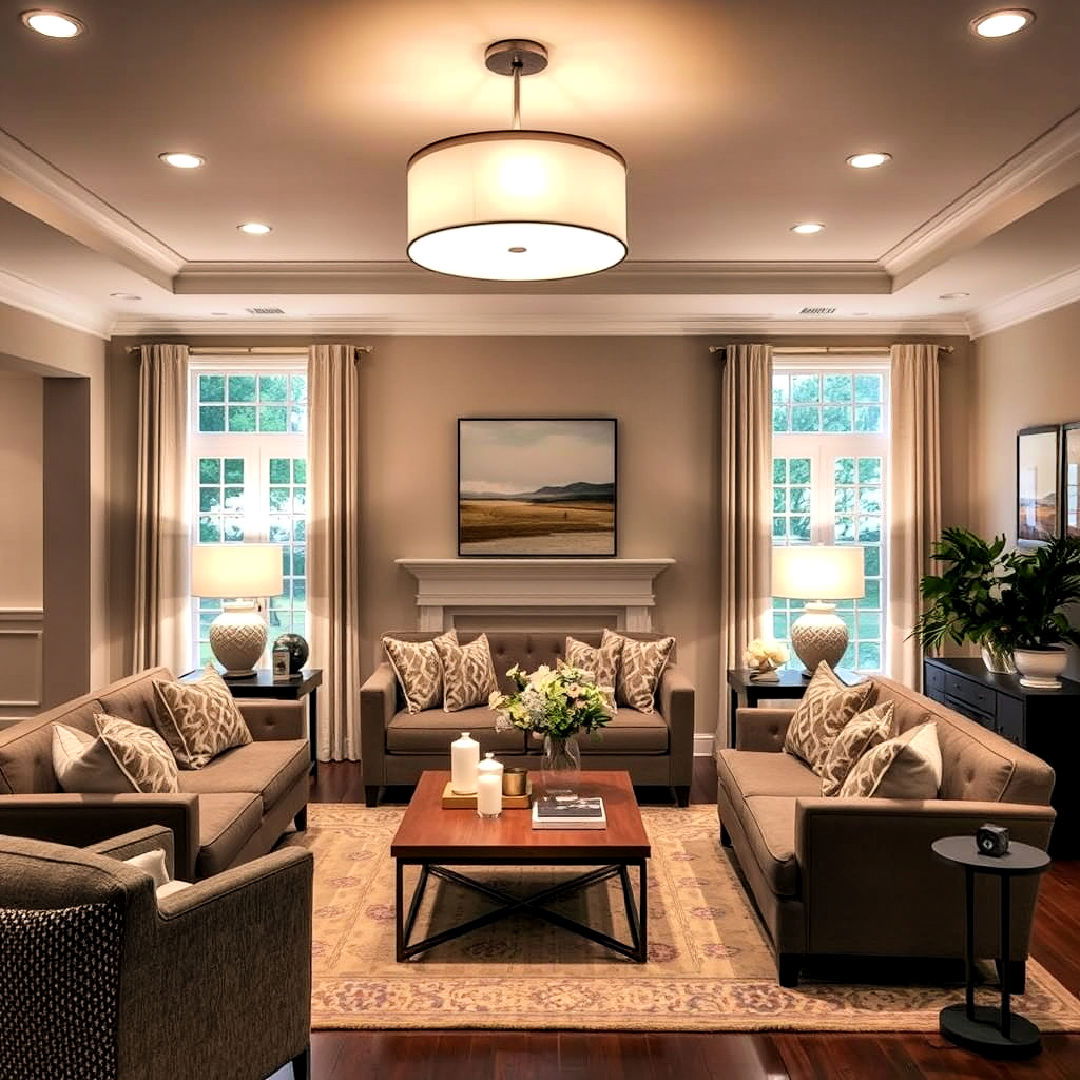
Achieve a cozy ambiance with a warm neutral transitional living room featuring soft tones and balanced decor. Layered lighting is essential for creating a cozy, inviting atmosphere in a transitional living room. Combine overhead lighting, like recessed fixtures or a chandelier, with table lamps and floor lamps. Soft, adjustable lighting allows for various moods and highlights key areas of the room, maintaining both function and ambiance.
14. Introduce Oversized Art
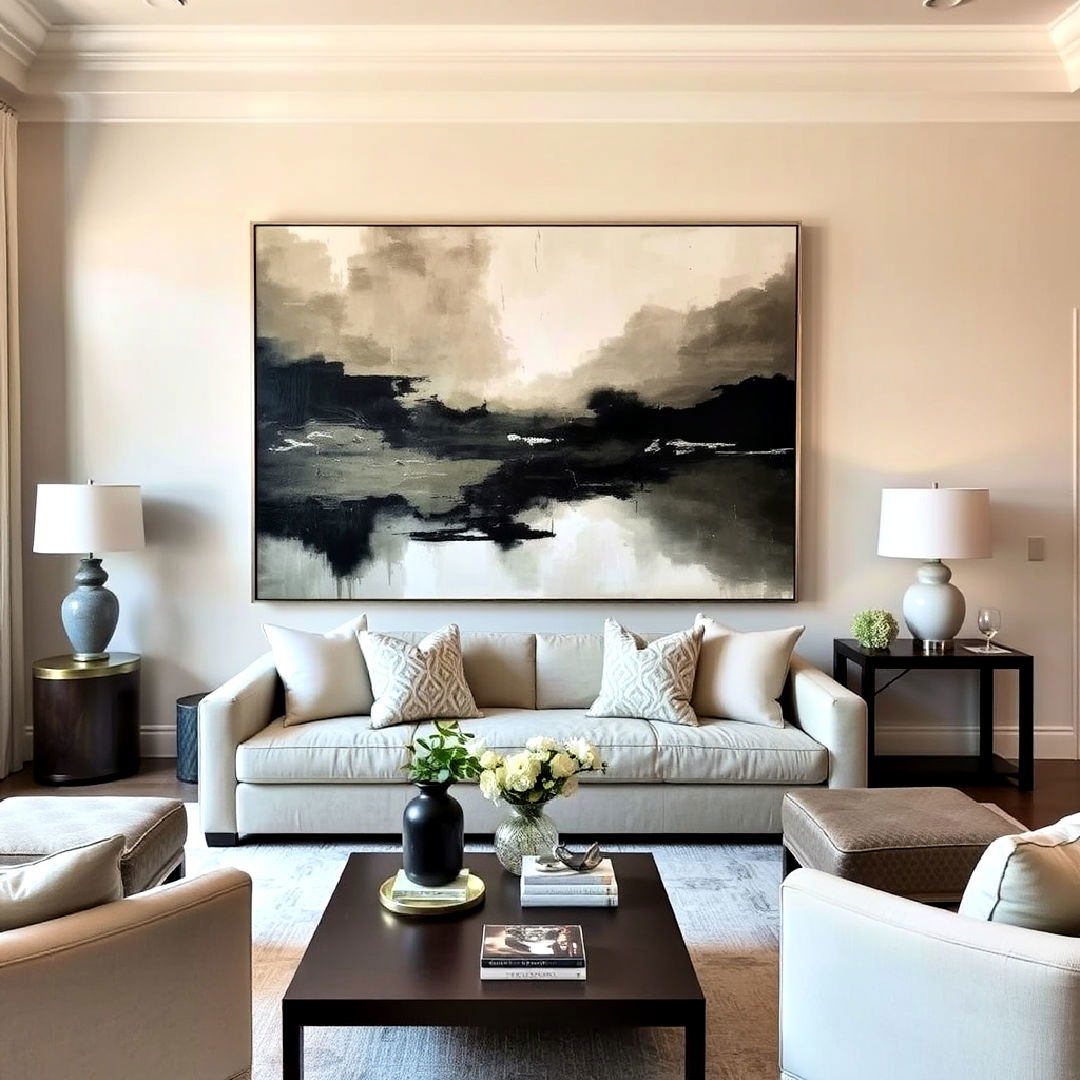
Large-scale artwork makes a bold statement in a transitional living room while still keeping the space cohesive. Whether it’s an abstract painting or a serene landscape, oversized art pieces add drama and sophistication without cluttering the design. This approach works particularly well with neutral walls, allowing the artwork to truly shine.
15. Use Glass and Transparent Furniture
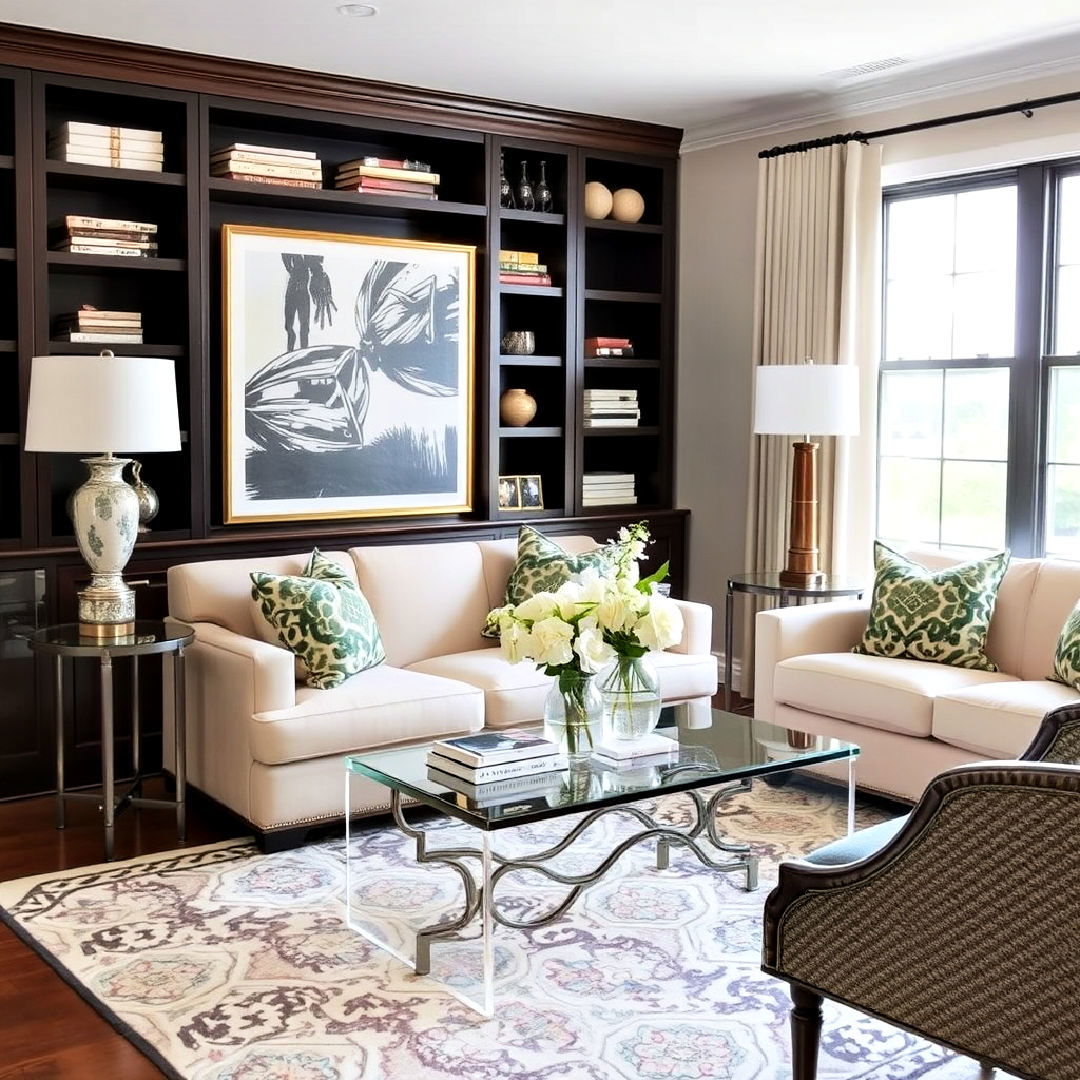
Glass and acrylic furniture pieces can add a touch of modernity to a transitional space without overwhelming it. Consider a glass coffee table or acrylic chairs to keep the room feeling open and light. These pieces blend effortlessly with traditional furnishings while introducing a sleek, contemporary edge to the design.
16. Opt for Plush Upholstery
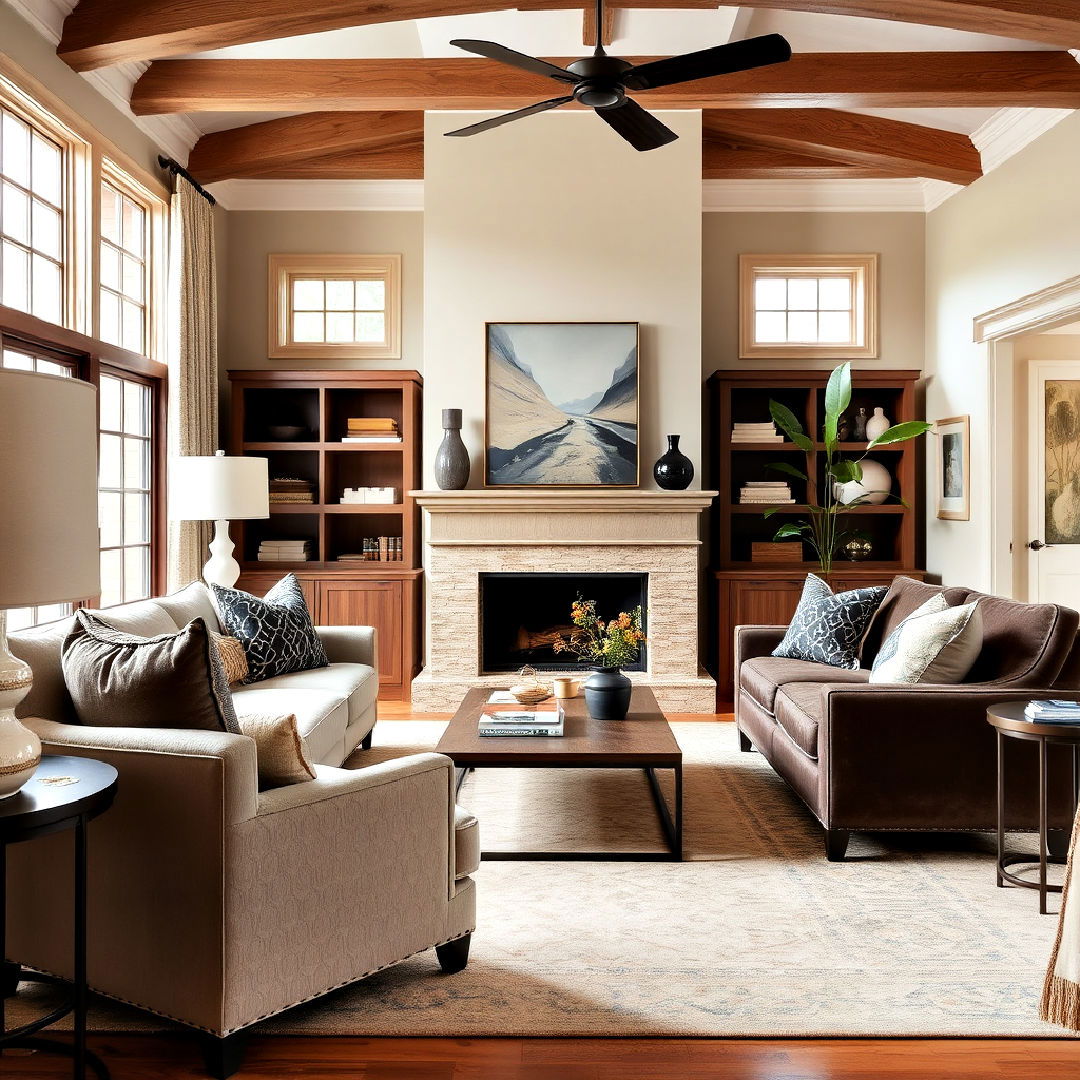
Transitional living rooms benefit from plush, comfortable seating. Choose upholstered sofas and chairs with soft fabrics like velvet or linen. These materials not only offer a luxurious feel but also balance the clean lines of modern furniture with the comfort of traditional pieces, ensuring the room remains inviting and cozy.
17. Embrace Minimalist Window Treatments
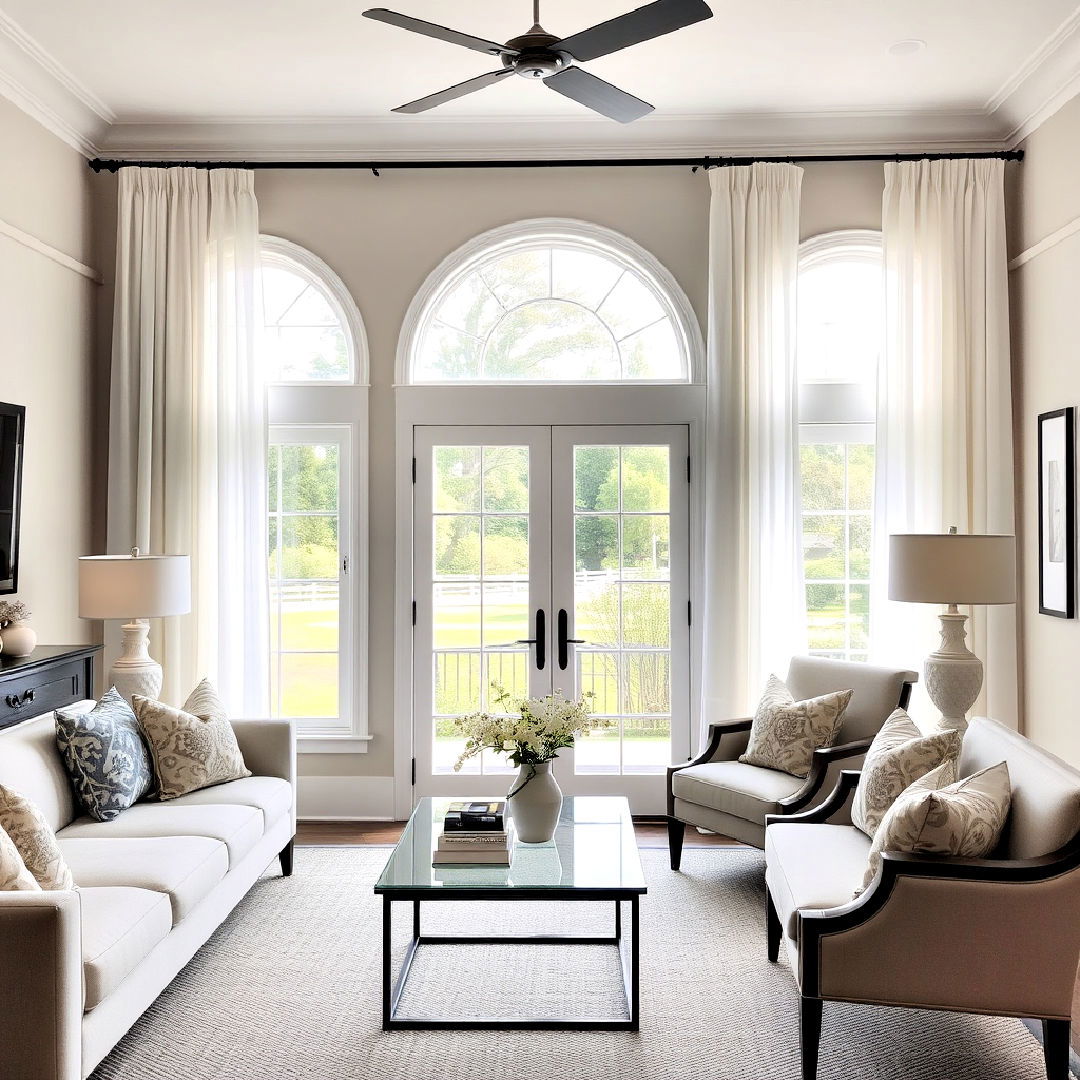
Keep window treatments simple and elegant in a transitional living room. Choose light, sheer curtains, or streamlined Roman shades to allow natural light to flood the space. By opting for minimal designs, the windows feel more open, contributing to the room’s airy and balanced aesthetic.
18. Add Natural Elements
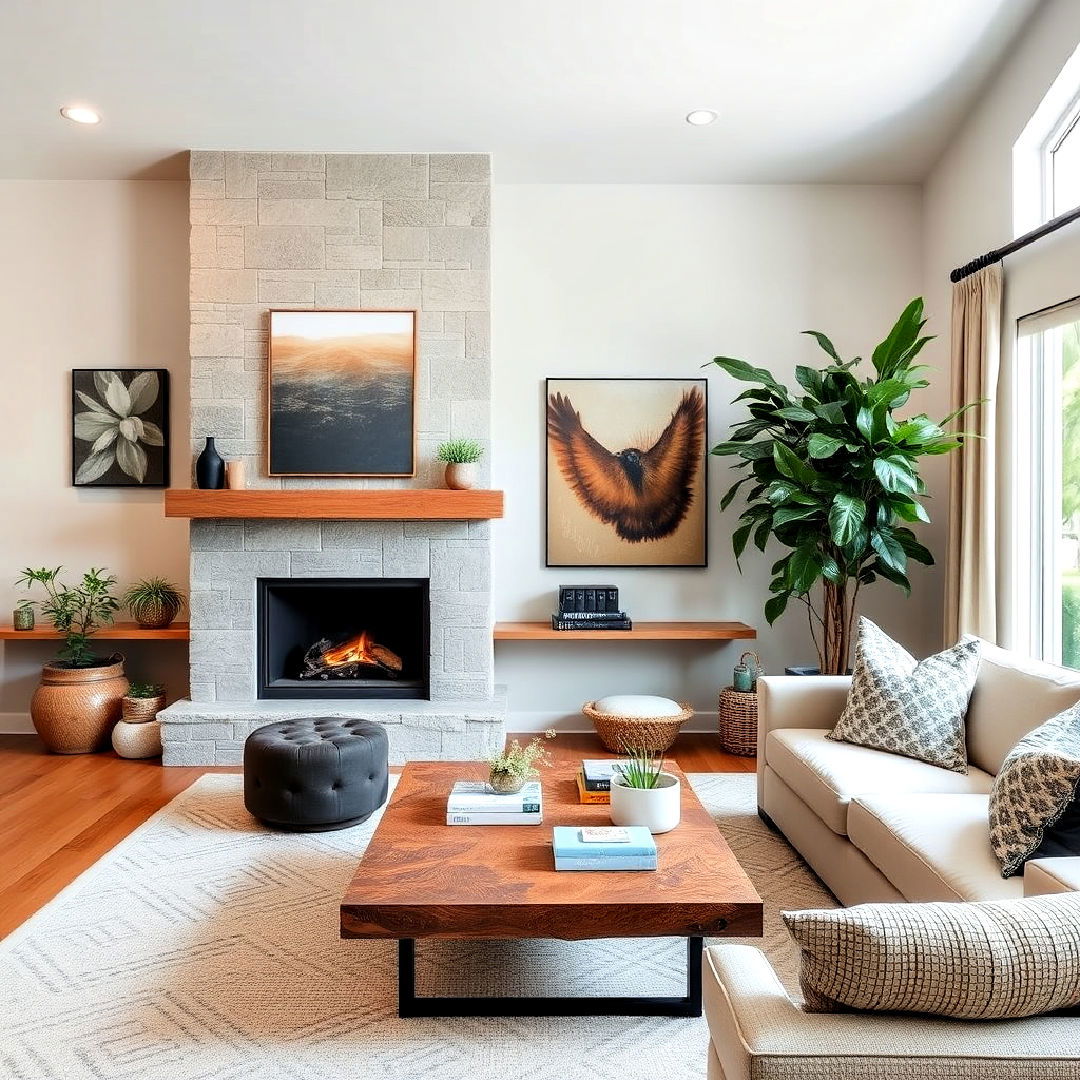
Enhance your home with a living room transitional style interior design for a stylish and adaptable environment. Natural materials, such as stone, wood, and plants, can soften the clean lines of a transitional living room. A wooden coffee table, a stone mantel, or even a large indoor plant brings warmth and texture into the space. These organic elements introduce a sense of tranquility and balance, enhancing the overall harmony of the room.
19. Incorporate a Statement Mirror
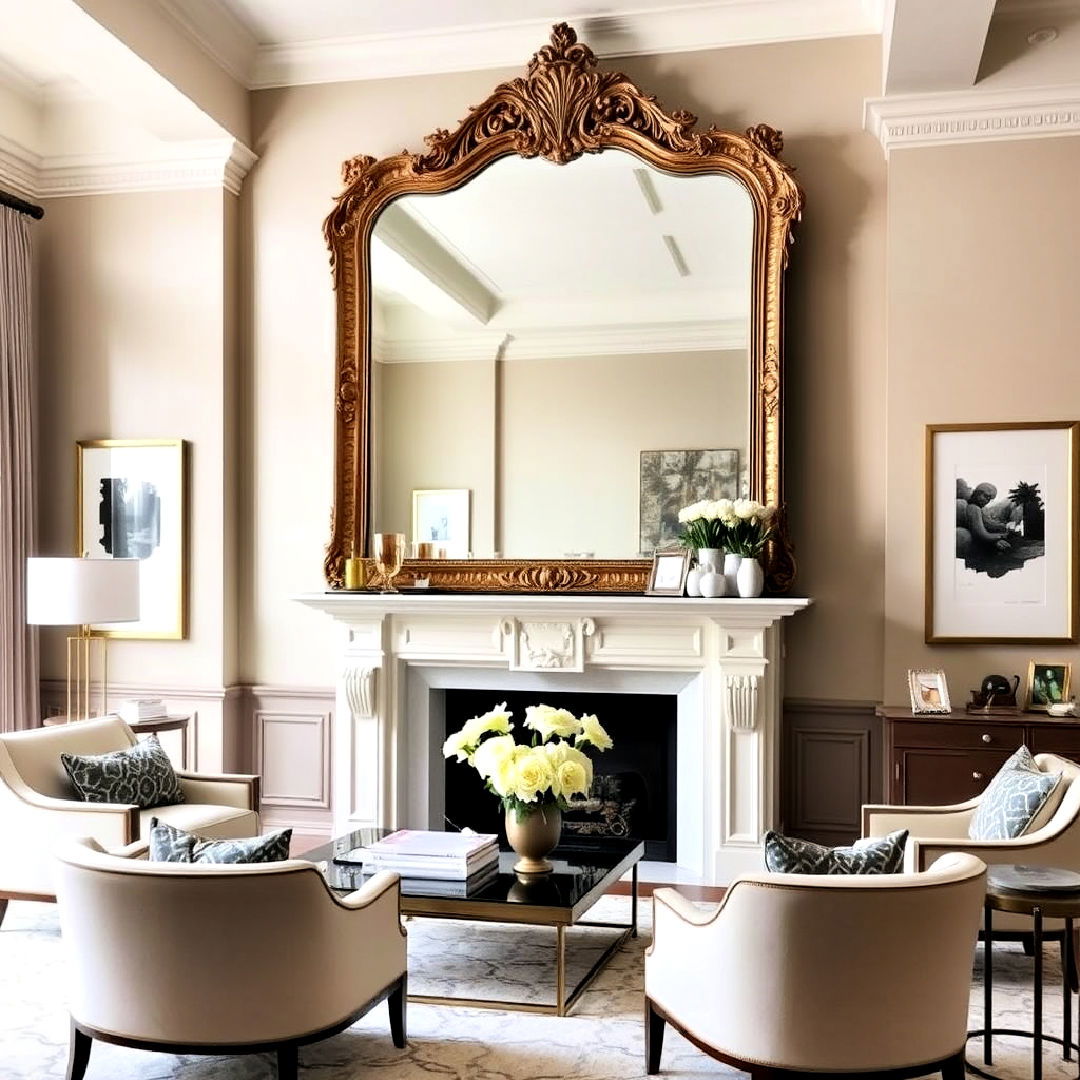
A large, ornate mirror can become a stunning focal point in a transitional living room. Whether positioned above the fireplace or on a feature wall, mirrors enhance the room by reflecting light and creating the illusion of more space. The blend of traditional detailing with modern placement adds a unique, elegant touch.
20. Use Subtle Patterns

While transitional living rooms often favor neutral tones, incorporating subtle patterns can add interest without overwhelming the design. Opt for delicate geometric or floral patterns in throw pillows, rugs, or curtains. These understated designs add texture and depth, complementing the room’s elegant simplicity while maintaining a sophisticated vibe.
21. Mix Matte and Glossy Finishes
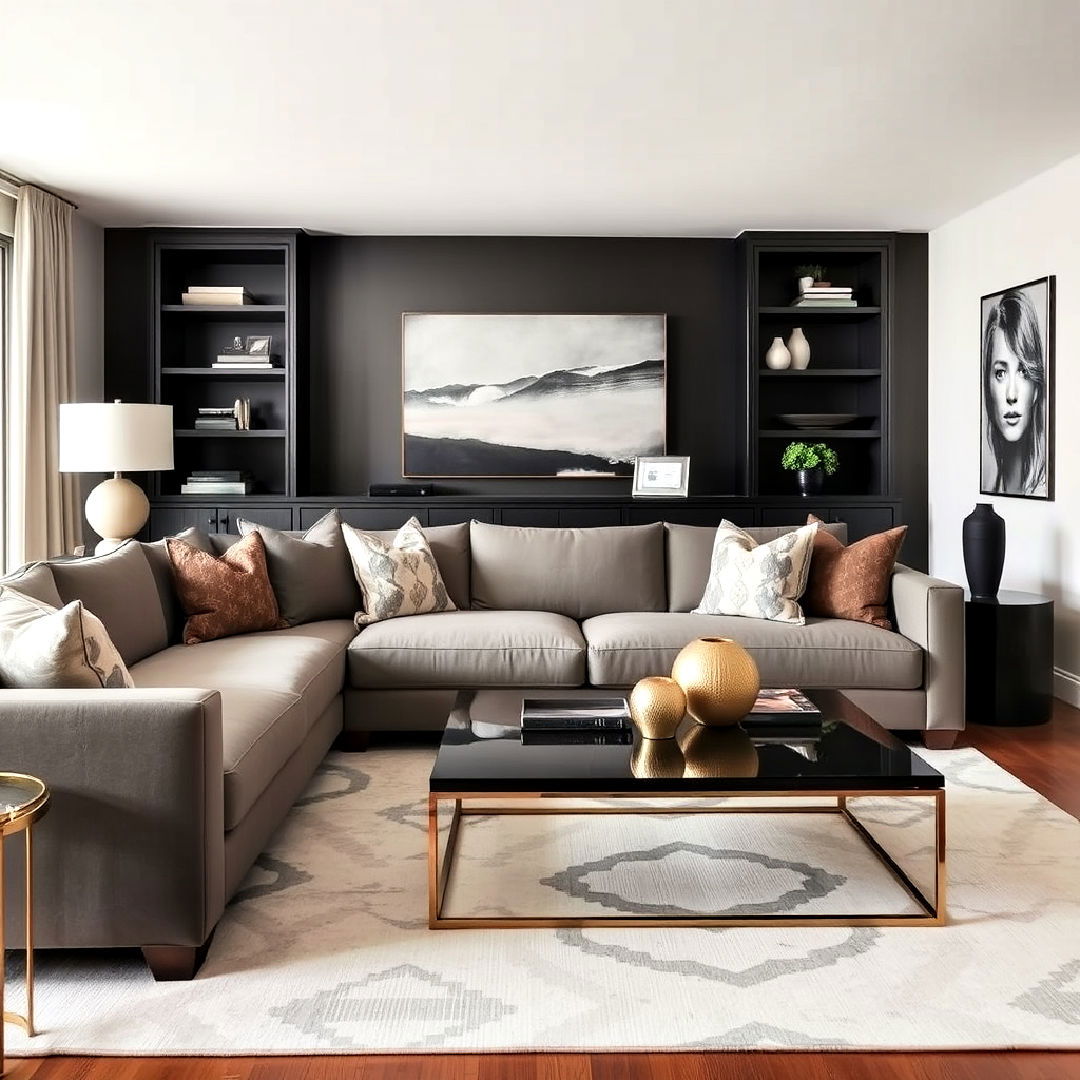
Balancing matte and glossy finishes can create a dynamic yet understated aesthetic in a transitional living room. A matte-finish sofa paired with glossy accents like a lacquered coffee table or metallic accessories adds a subtle contrast. This interplay of textures keeps the room visually interesting while maintaining a sleek, sophisticated feel.
22. Incorporate Geometric Patterns
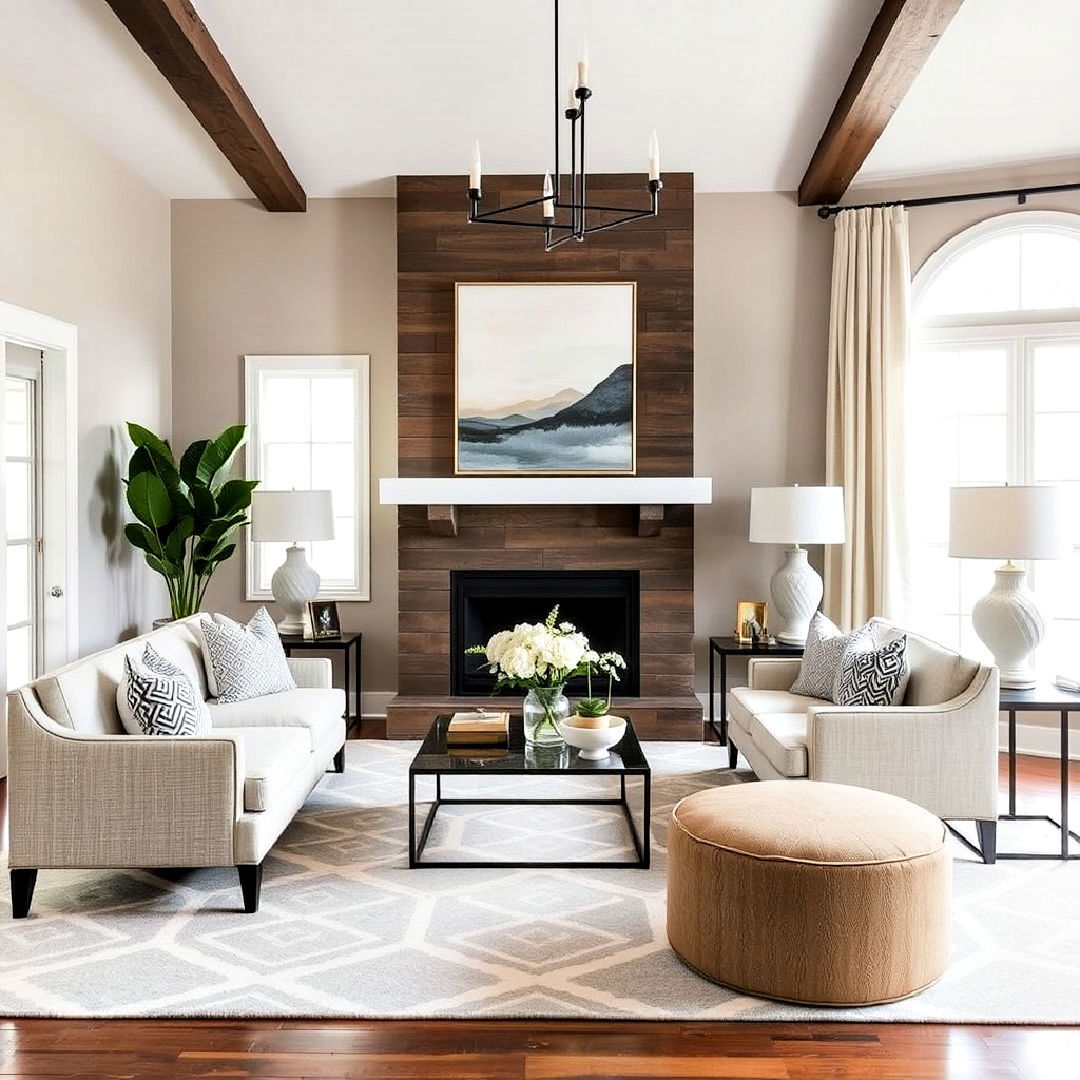
Introduce geometric patterns into your transitional living room through accent pieces like pillows, rugs, or artwork. These shapes provide a modern edge without overwhelming the room. When kept in neutral tones or muted shades, geometric patterns add depth and style while keeping the design cohesive and elegant.
23. Use Floating Shelves for a Contemporary Look
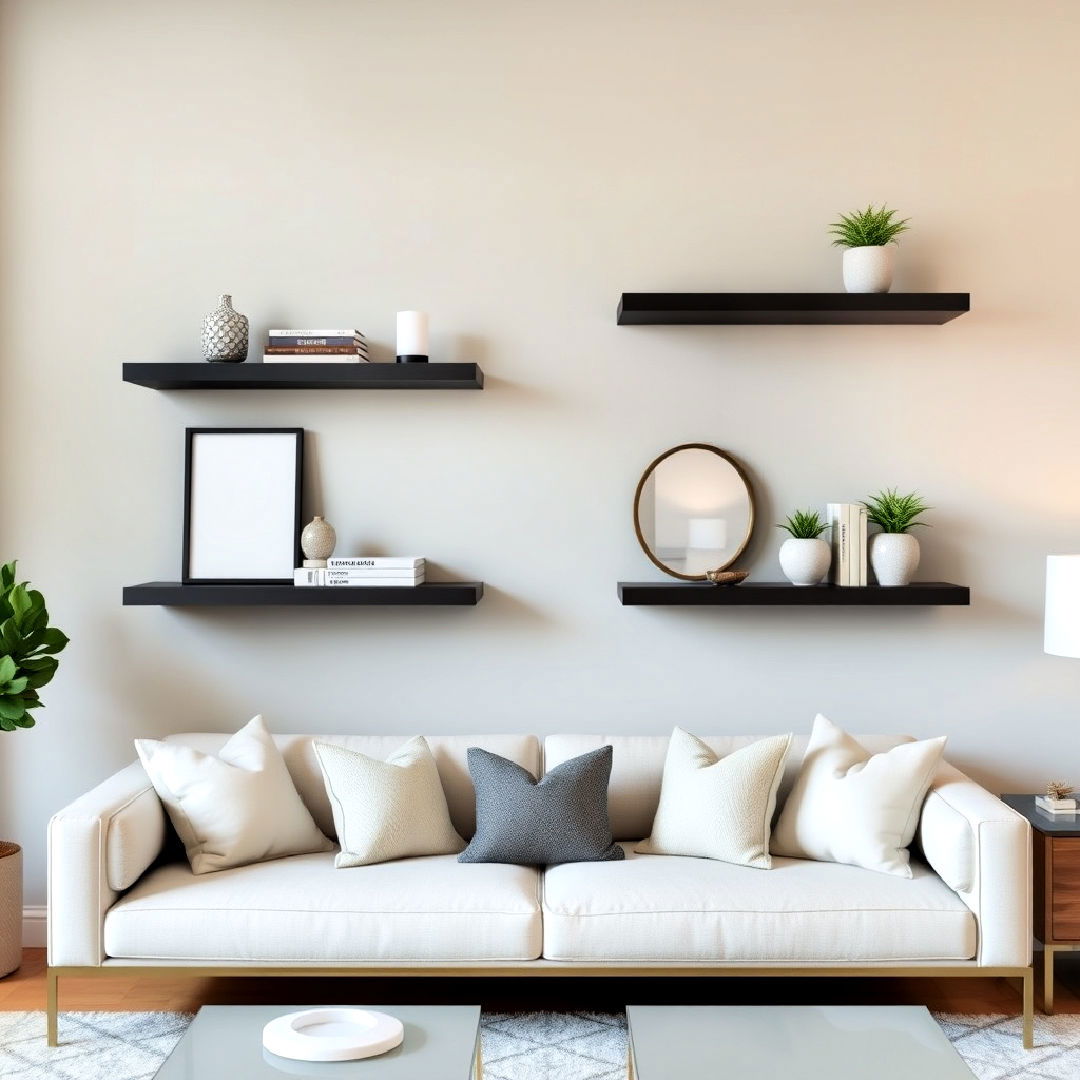
Update your space with transitional decor living room elements that combine classic and contemporary pieces. Floating shelves offer a minimalist and clean way to display decor while keeping the room open and airy. They provide an opportunity to showcase decorative objects, small plants, or books without adding the bulk of traditional shelving units. This modern approach complements the simplicity of a transitional living room design.
24. Integrate a Mix of Soft and Hard Textures
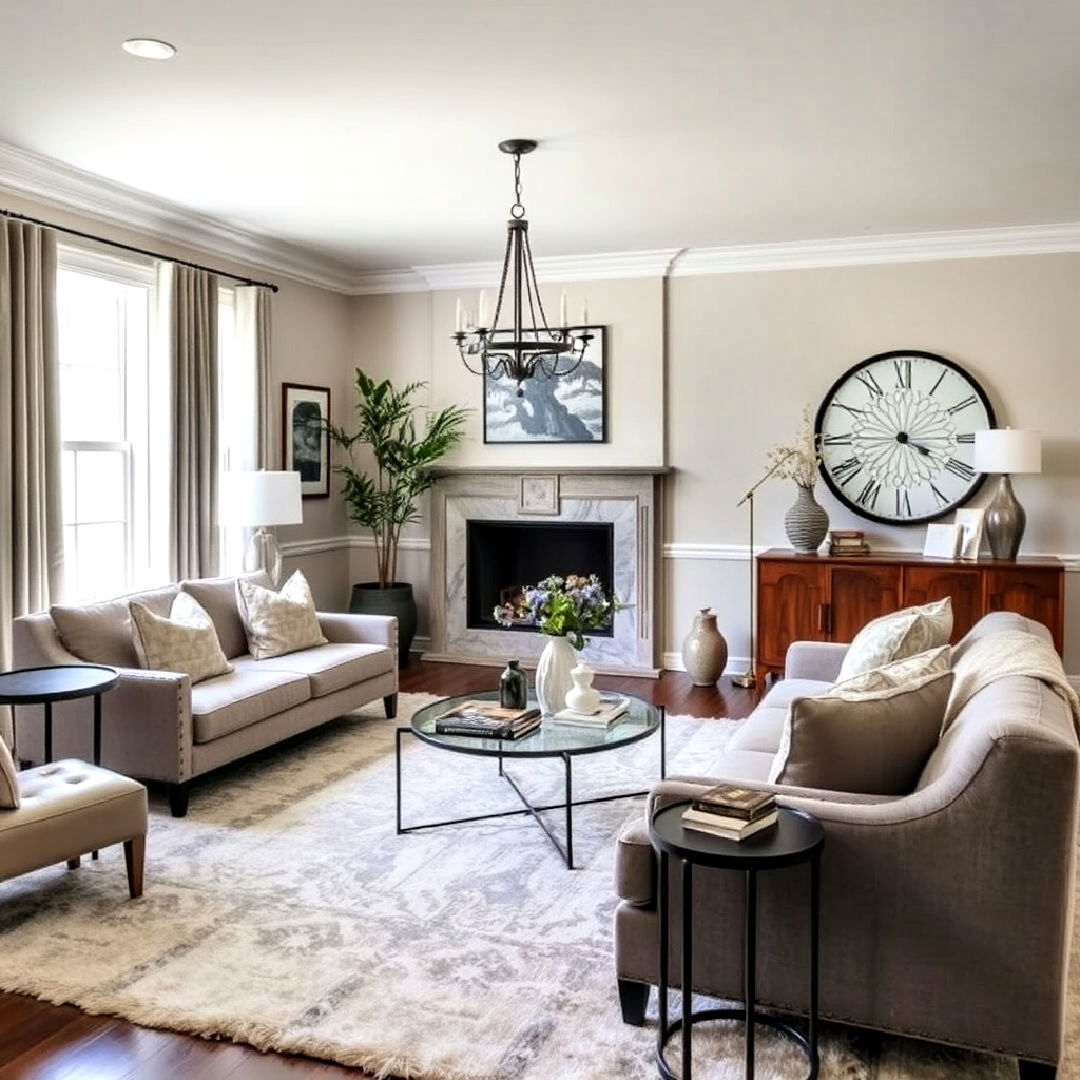
Balancing soft and hard textures enhances the tactile appeal of a transitional living room. Pair soft elements like a plush rug or velvet pillows with harder materials like a metal coffee table or wooden sideboard. This contrast creates a layered look that feels inviting yet structured, blending modern and traditional influences seamlessly.
25. Create a Gallery Wall
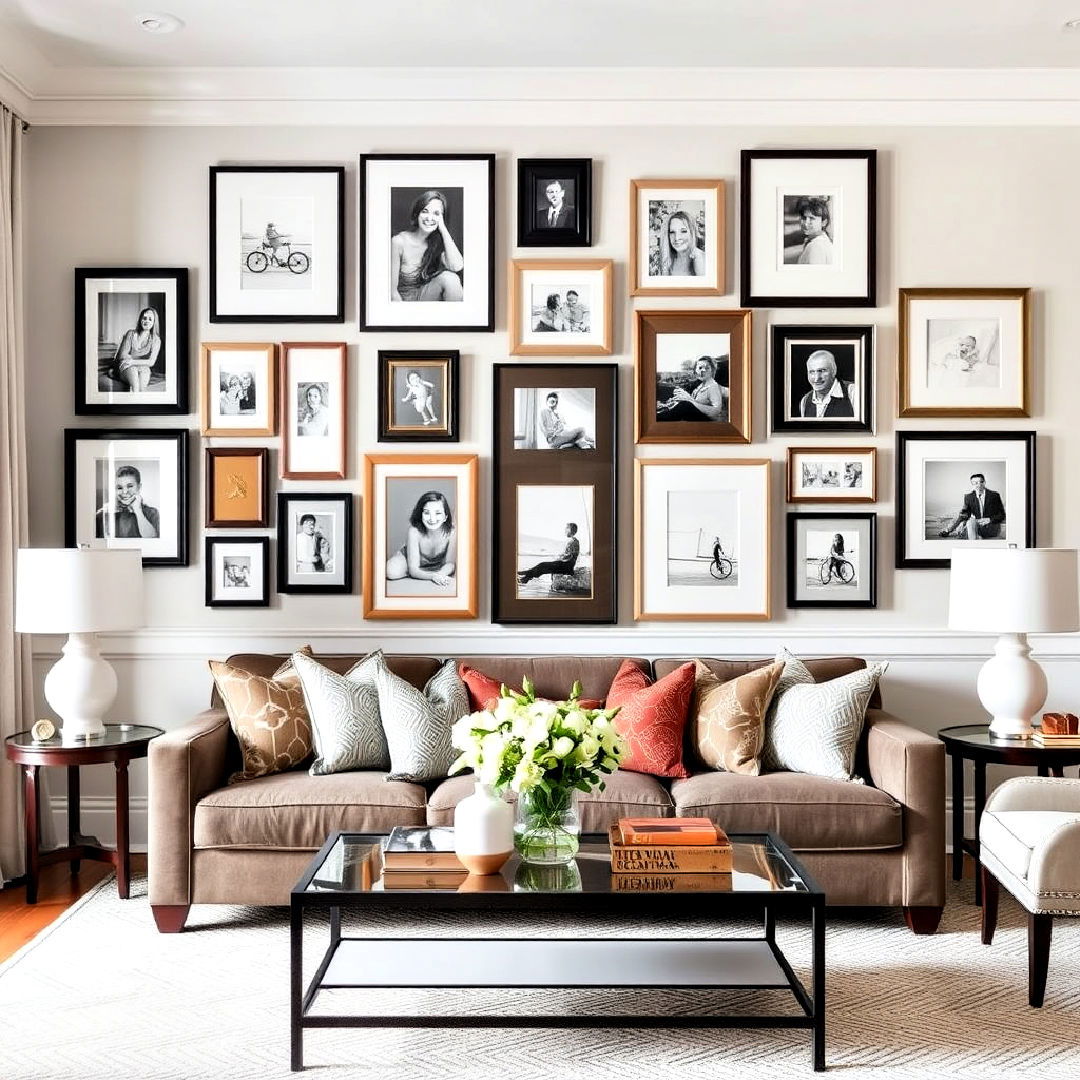
A curated gallery wall can serve as a personal and artistic focal point in a transitional living room. Combine a mix of frame styles and sizes, or use uniform frames for a clean look. Whether it features family photos, artwork, or prints, a gallery wall adds character while maintaining the room's overall polished and balanced design.
26. Go for Dark Accent Walls
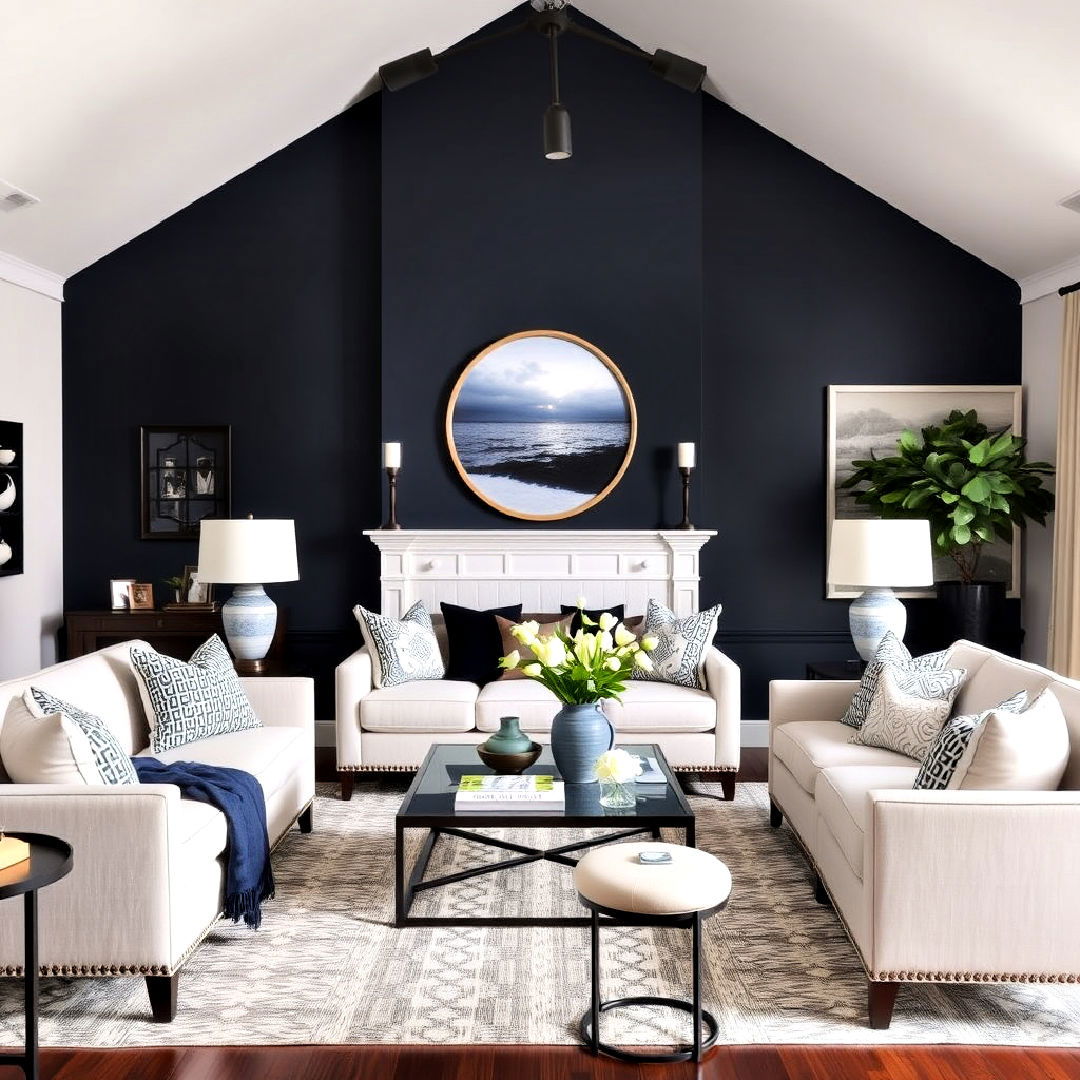
A deep, rich color on one accent wall can bring drama and sophistication to a transitional living room. Navy, charcoal, or forest green are popular choices that pair well with neutral furnishings. The darker hue creates a bold contrast without compromising the room’s elegant, tranquil atmosphere.
27. Introduce Statement Furniture Pieces
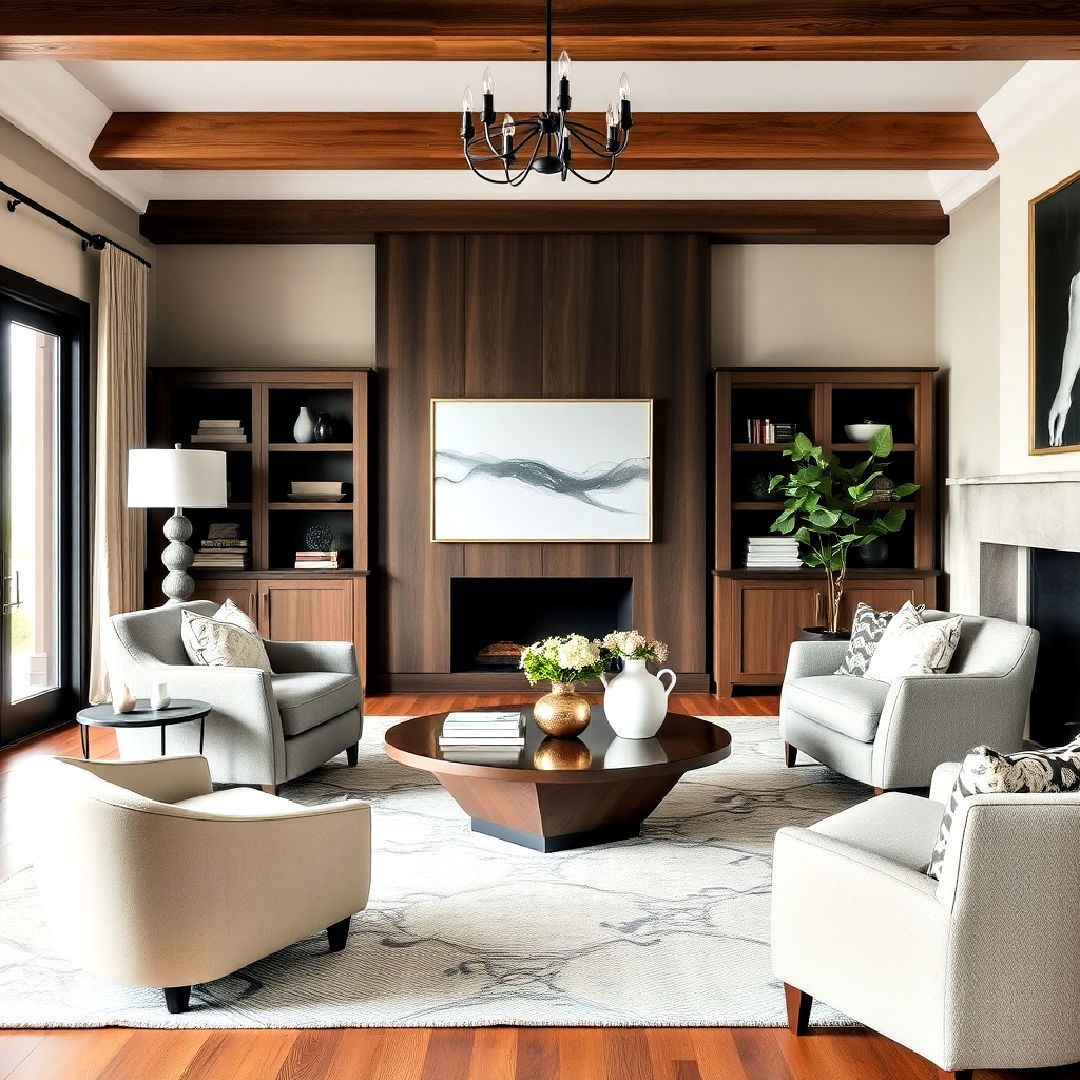
A standout furniture piece, such as an oversized armchair or a sculptural coffee table, can elevate the style of a transitional living room. These statement pieces become focal points, anchoring the space while allowing other elements to remain understated. This approach adds a touch of personality to a balanced design.
28. Keep Floors Neutral and Timeless
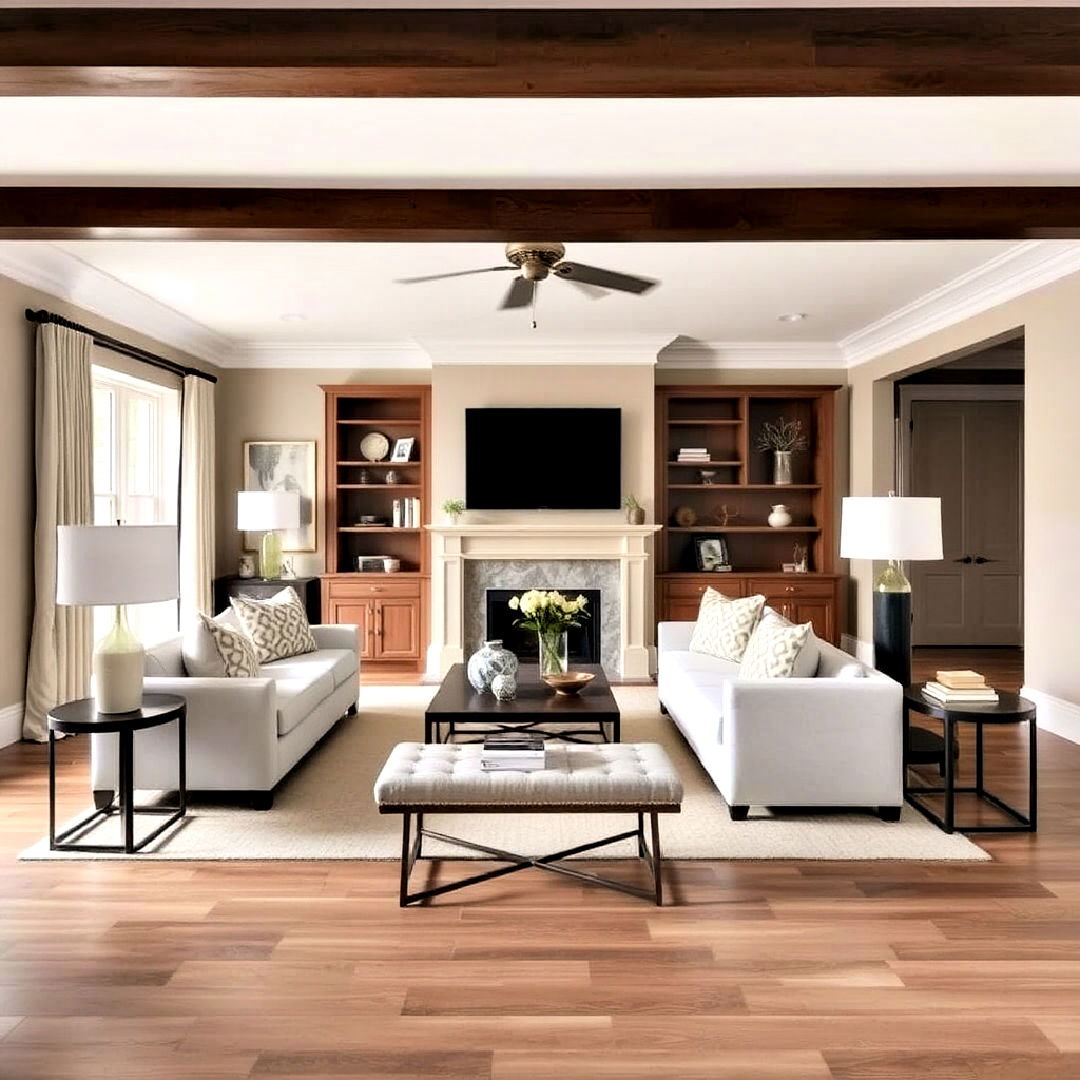
Neutral, understated flooring helps ground a transitional living room while allowing other elements to shine. Whether it's hardwood, stone, or simple carpeting, keeping the floor in muted tones allows you to play with bolder furniture and decor. The simplicity of neutral flooring contributes to the room’s classic-meets-modern vibe.
29. Balance Old and New Accessories
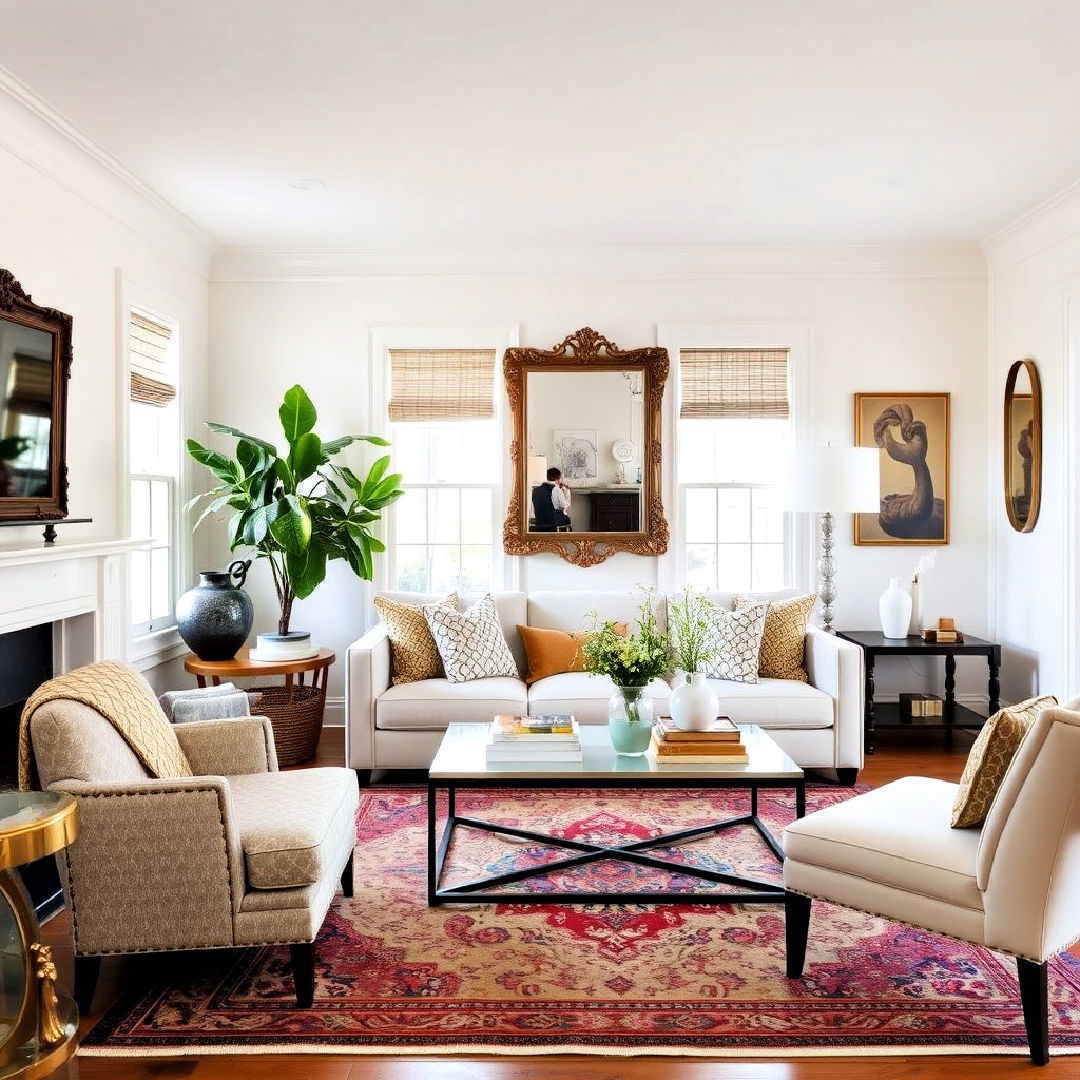
Discover inspiring transitional living rooms that effortlessly merge different design aesthetics. Decorate with a thoughtful mix of vintage and contemporary accessories. A modern vase paired with an antique mirror or a vintage rug beneath a sleek coffee table creates a harmonious blend of eras. This balanced mix adds depth and narrative to the room, making it feel timeless and curated.
30. Keep the Layout Open and Flowing
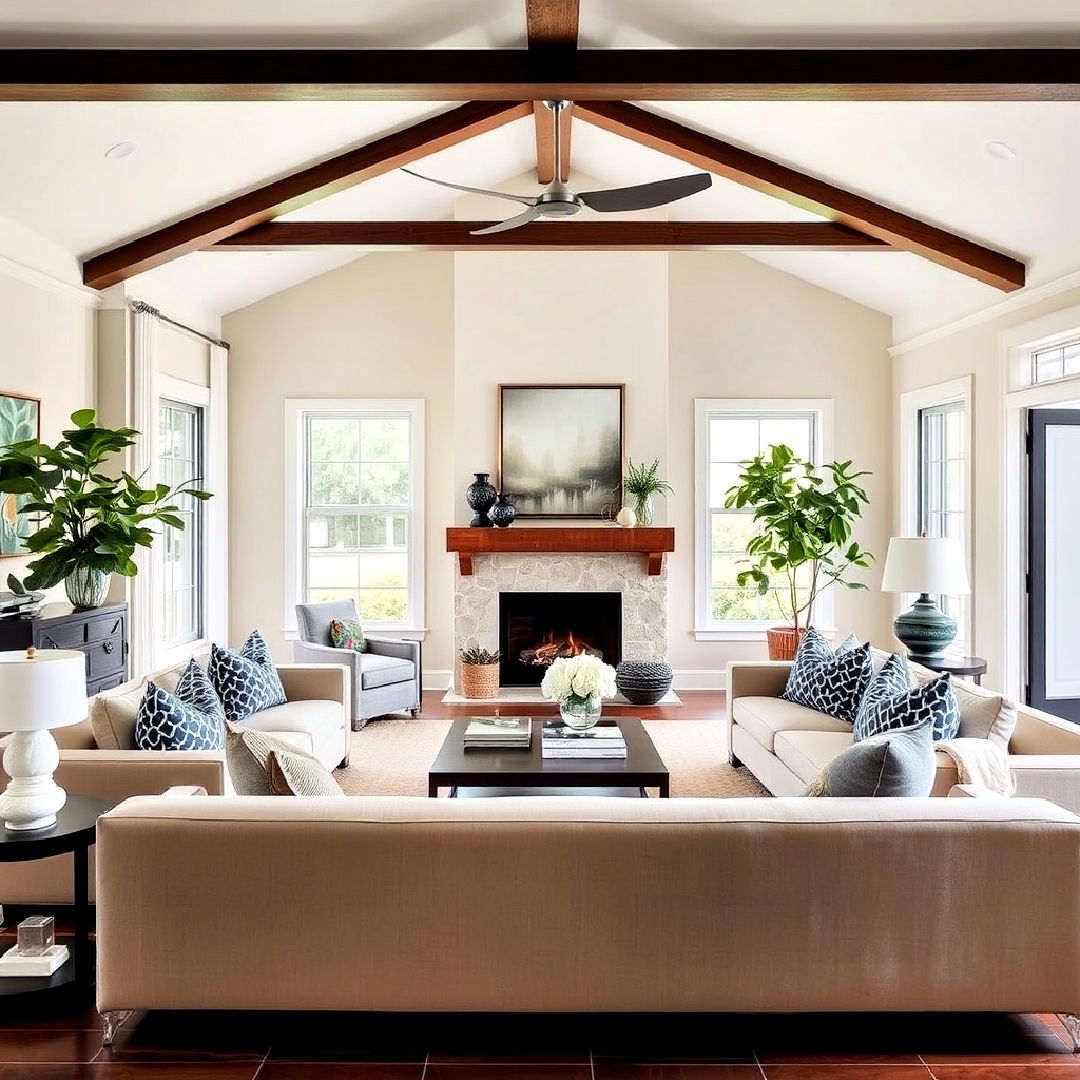
In a transitional living room, the layout should prioritize openness and ease of movement. Opt for a furniture arrangement that promotes conversation, with seating oriented around a central focal point like a fireplace or coffee table. This open, flowing layout encourages interaction and creates a welcoming, uncluttered atmosphere.
31. Add Cozy Throw Blankets
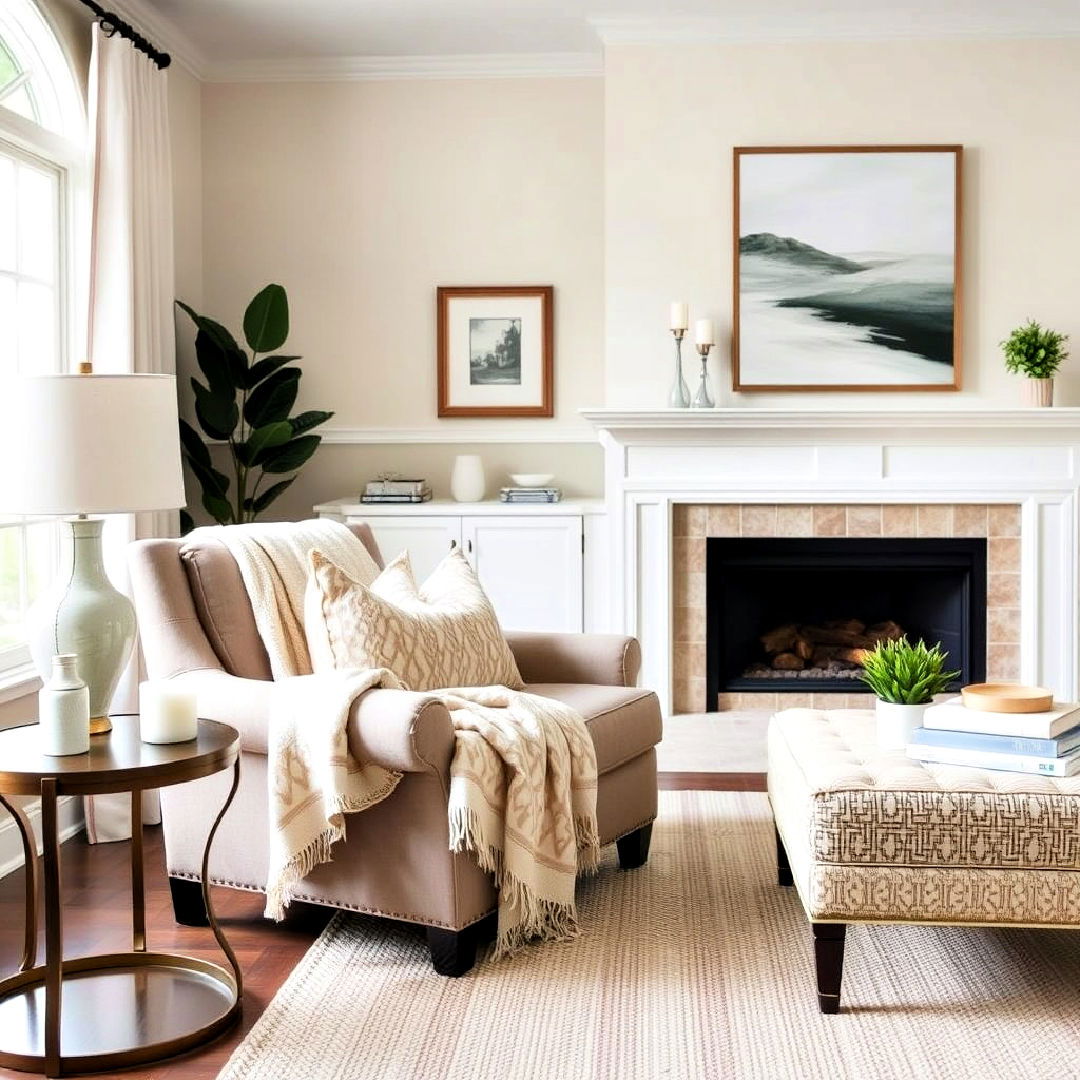
Draping a soft, cozy throw blanket over a sofa or armchair instantly adds warmth and texture to a transitional living room. Choose neutral tones or soft patterns that complement the rest of the room’s color scheme. This simple addition not only adds comfort but also creates an inviting and relaxed atmosphere.
32. Incorporate Statement Wallpaper
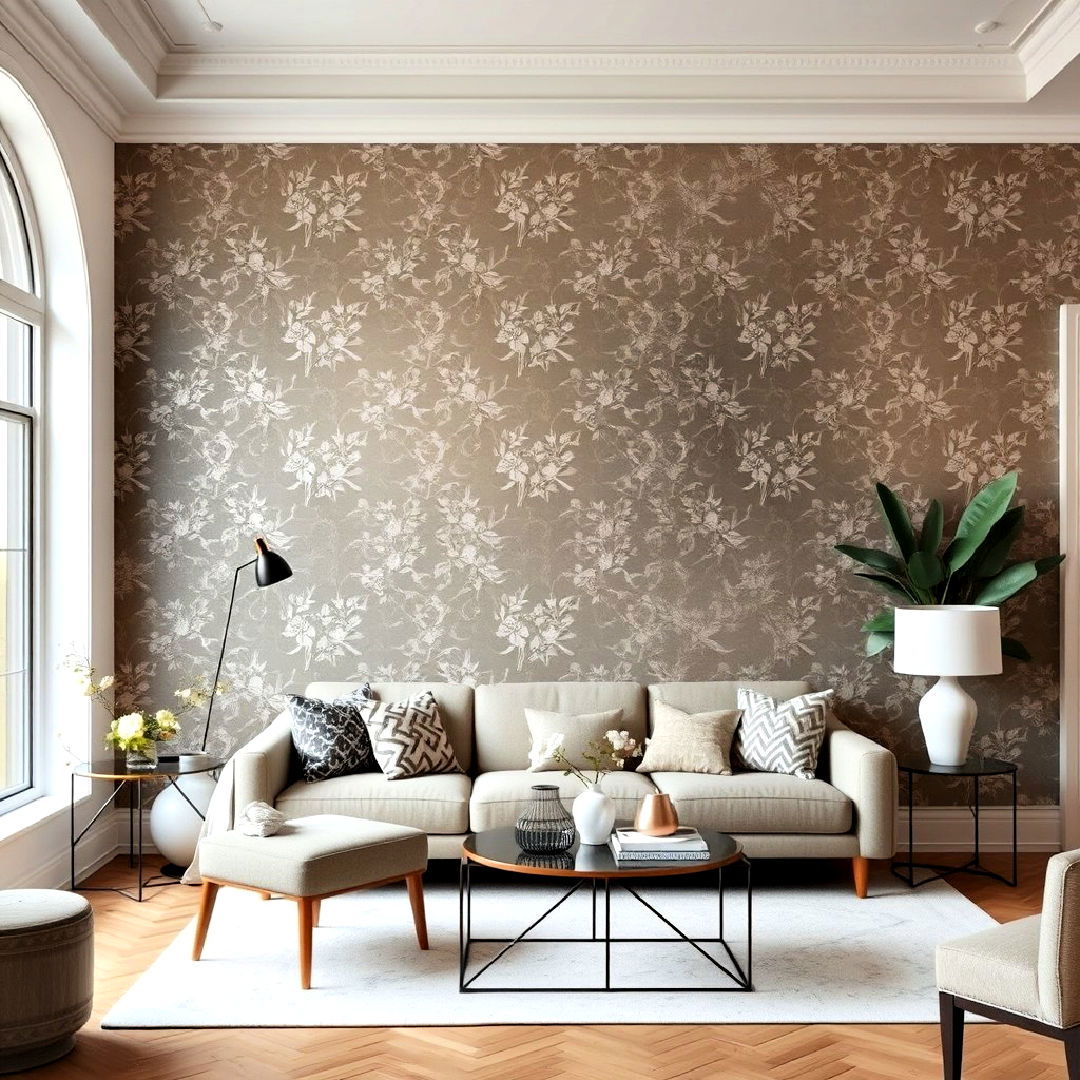
Statement wallpaper on a single wall can transform a transitional living room, adding personality without overpowering the design. Opt for subtle patterns or neutral tones that align with the room’s overall aesthetic. Whether it’s a delicate floral or a geometric design, wallpaper creates a visually striking focal point that adds depth to the space.
33. Use Metallic Accents for a Touch of Glamour
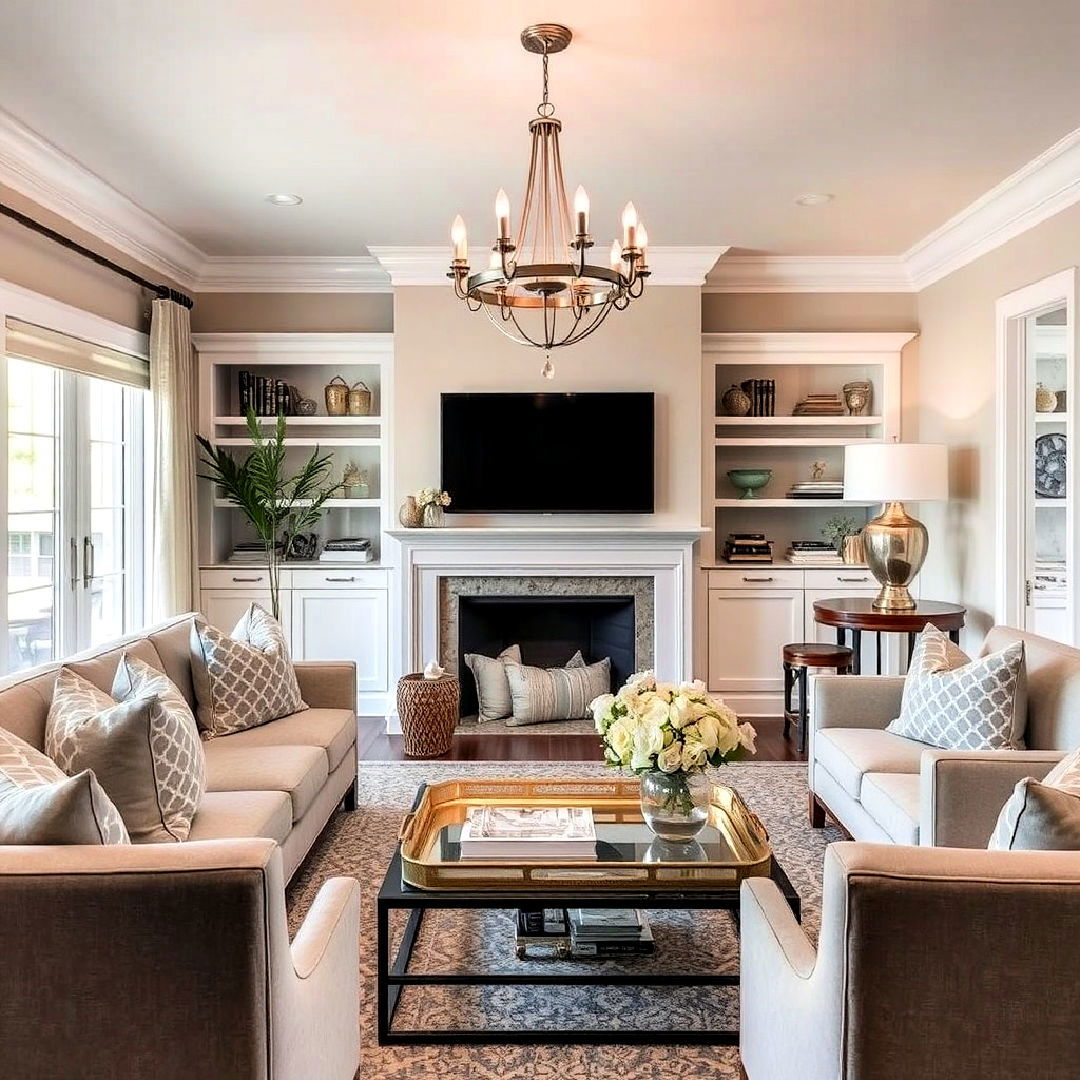
Adding metallic accents in gold, silver, or bronze gives a subtle touch of glamour to a transitional living room. Consider incorporating metallic elements through picture frames, light fixtures, or decorative trays. The reflective surfaces catch the light, creating a polished and sophisticated vibe while maintaining the room's elegant balance.
34. Incorporate Multi-functional Furniture
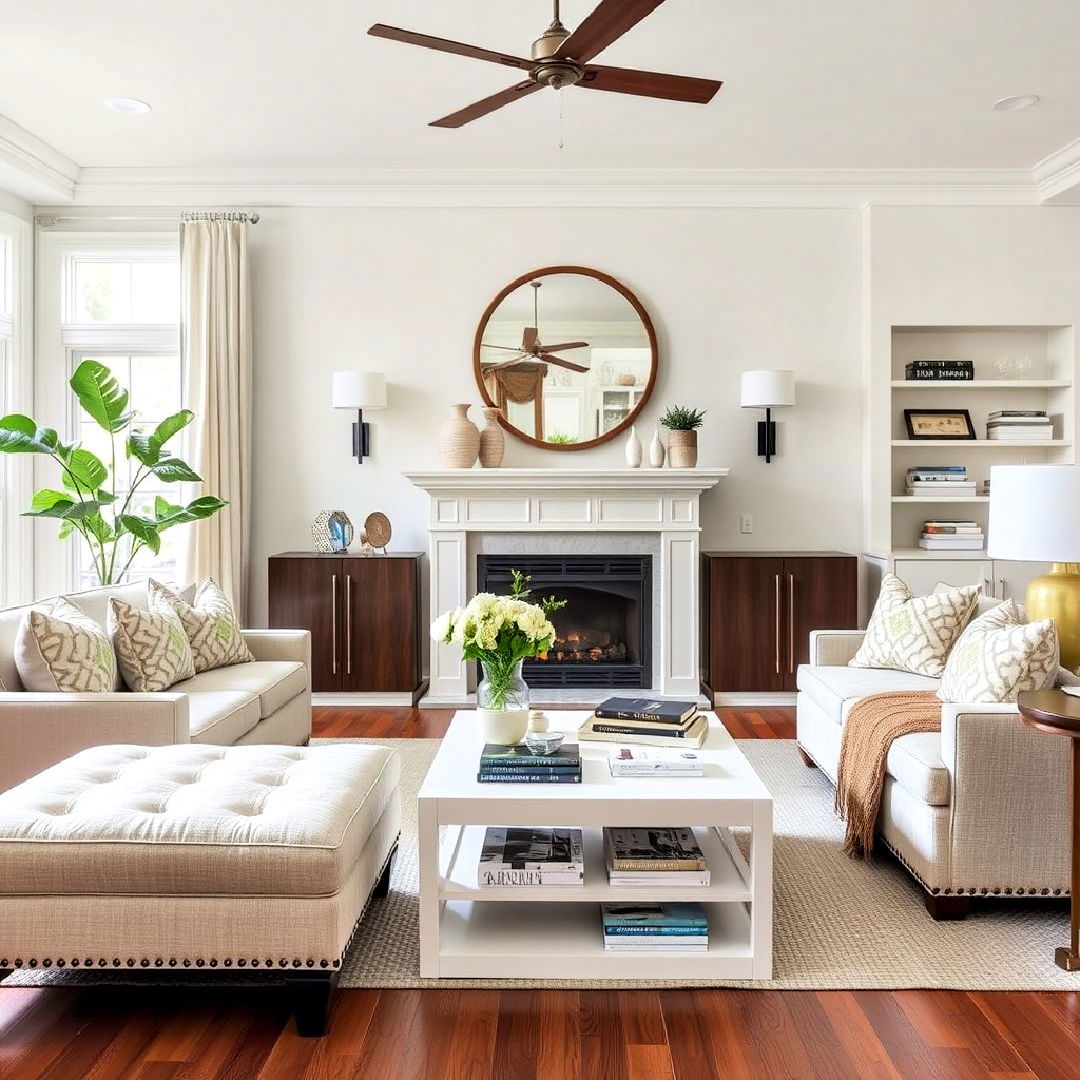
Choose multi-functional furniture pieces, such as an ottoman that doubles as storage or a coffee table with shelves underneath. These pieces are both practical and stylish, making the room more functional without sacrificing aesthetics. The combination of modern convenience and traditional style keeps the space feeling organized and timeless.
35. Opt for a Neutral Color Palette with Pops of Color
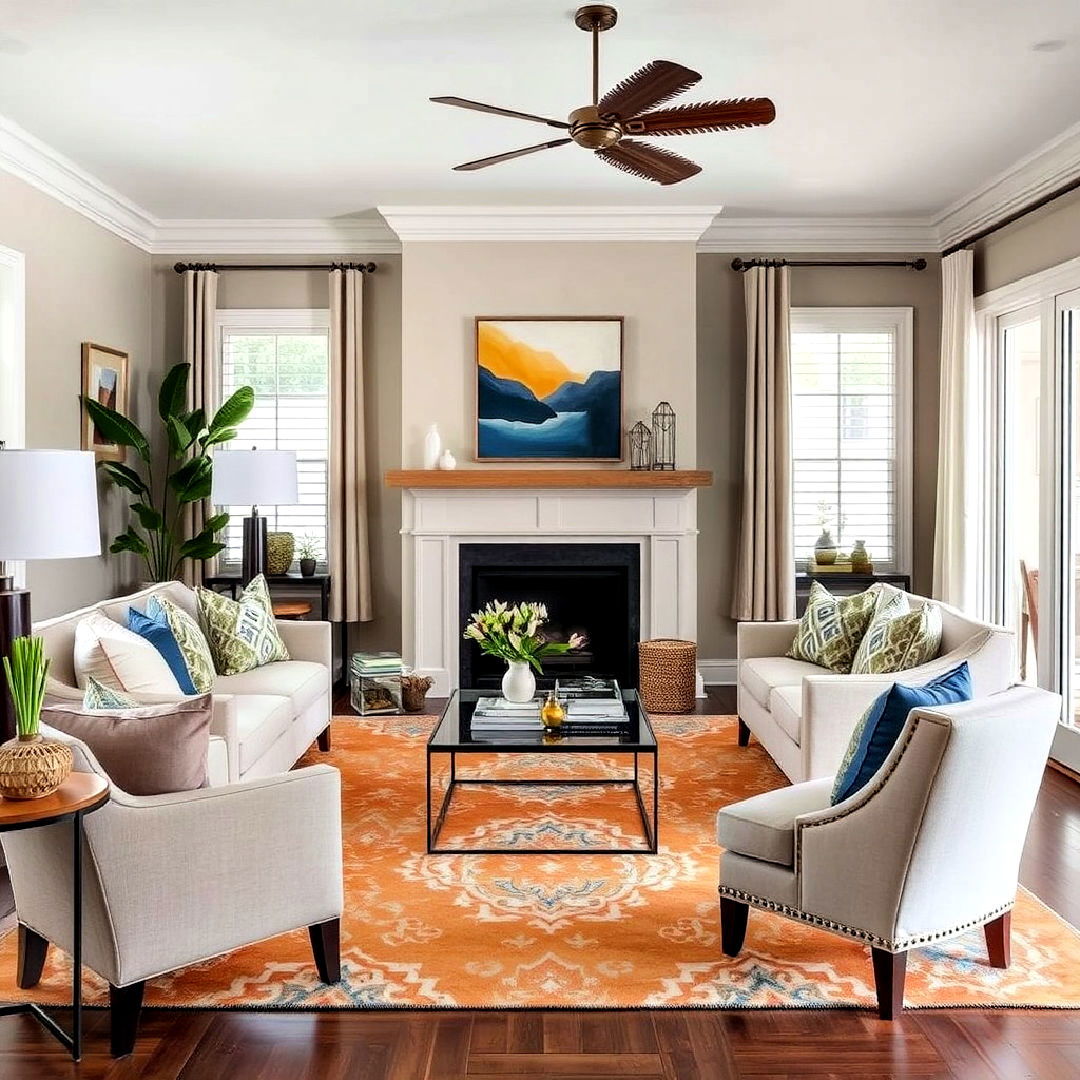
A neutral color palette provides a calming backdrop in a transitional living room, but adding a few pops of color can bring the space to life. Whether through accent pillows, artwork, or a colorful rug, small doses of bold hues like blue, mustard, or terracotta can energize the room without overwhelming the design.
36. Introduce Architectural Elements

Design a sleek and inviting space with a transitional modern living room that incorporates current trends and timeless features. Incorporate architectural elements, such as crown molding, wainscoting, or exposed beams, to add structure and interest to a transitional living room. These details provide a classic touch, blending well with modern furniture and decor. Architectural accents add depth and sophistication, elevating the overall look of the space.
37. Use Black Accents for Contrast
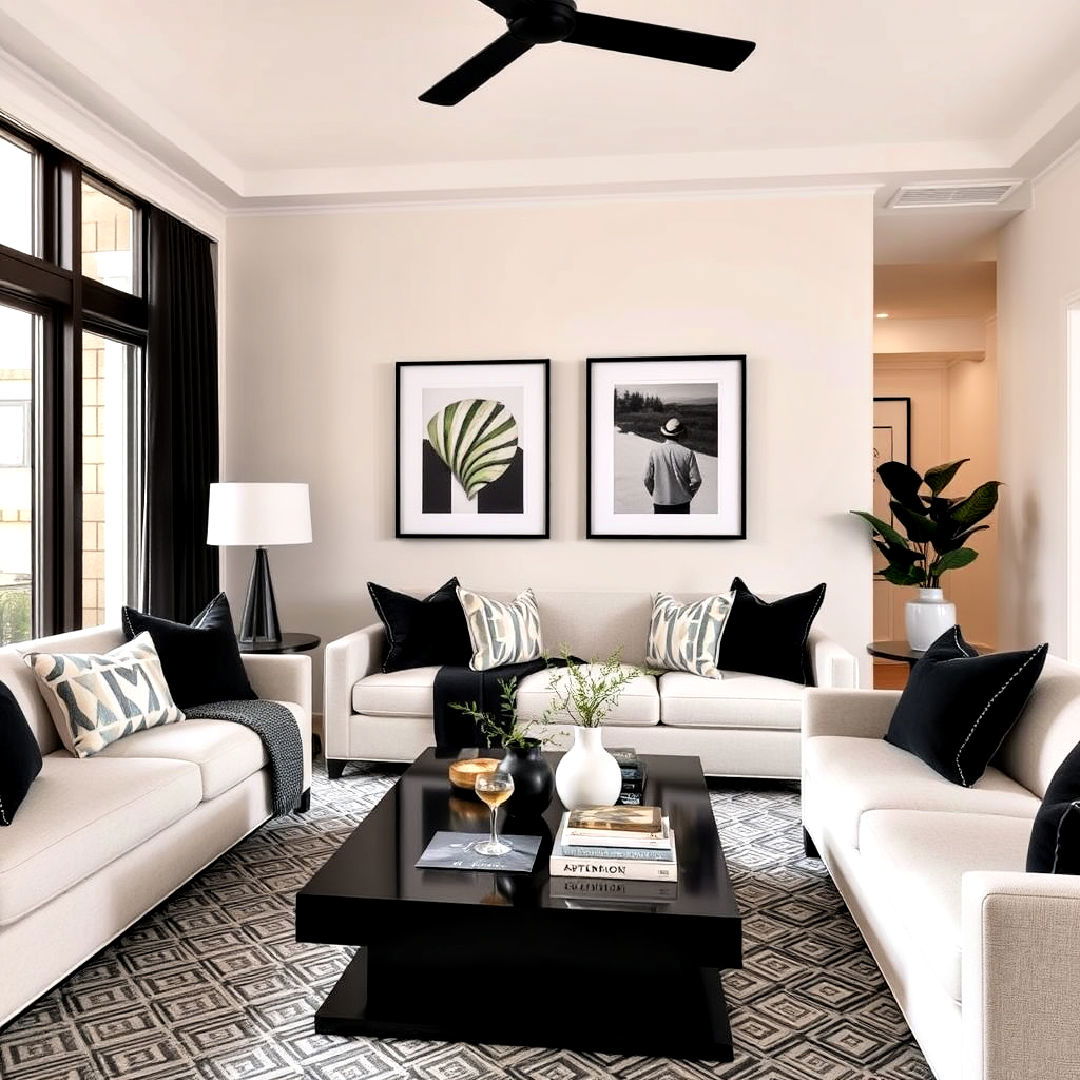
Incorporating black accents adds a modern, bold contrast to a transitional living room. Whether through black picture frames, a sleek black coffee table, or dark throw pillows, these touches create a sharp, clean contrast against lighter tones. Black accents ground the space and add a contemporary edge without disrupting the room's balance.
38. Create a Cozy Reading Nook

Designate a corner of your living room as a cozy reading nook with a comfortable chair, a small side table, and a stylish lamp. This small area adds both function and charm to the room, offering a quiet space for relaxation. A transitional-style chair with clean lines blends seamlessly into the overall design while providing comfort.
39. Incorporate Natural Light with Minimal Window Treatments
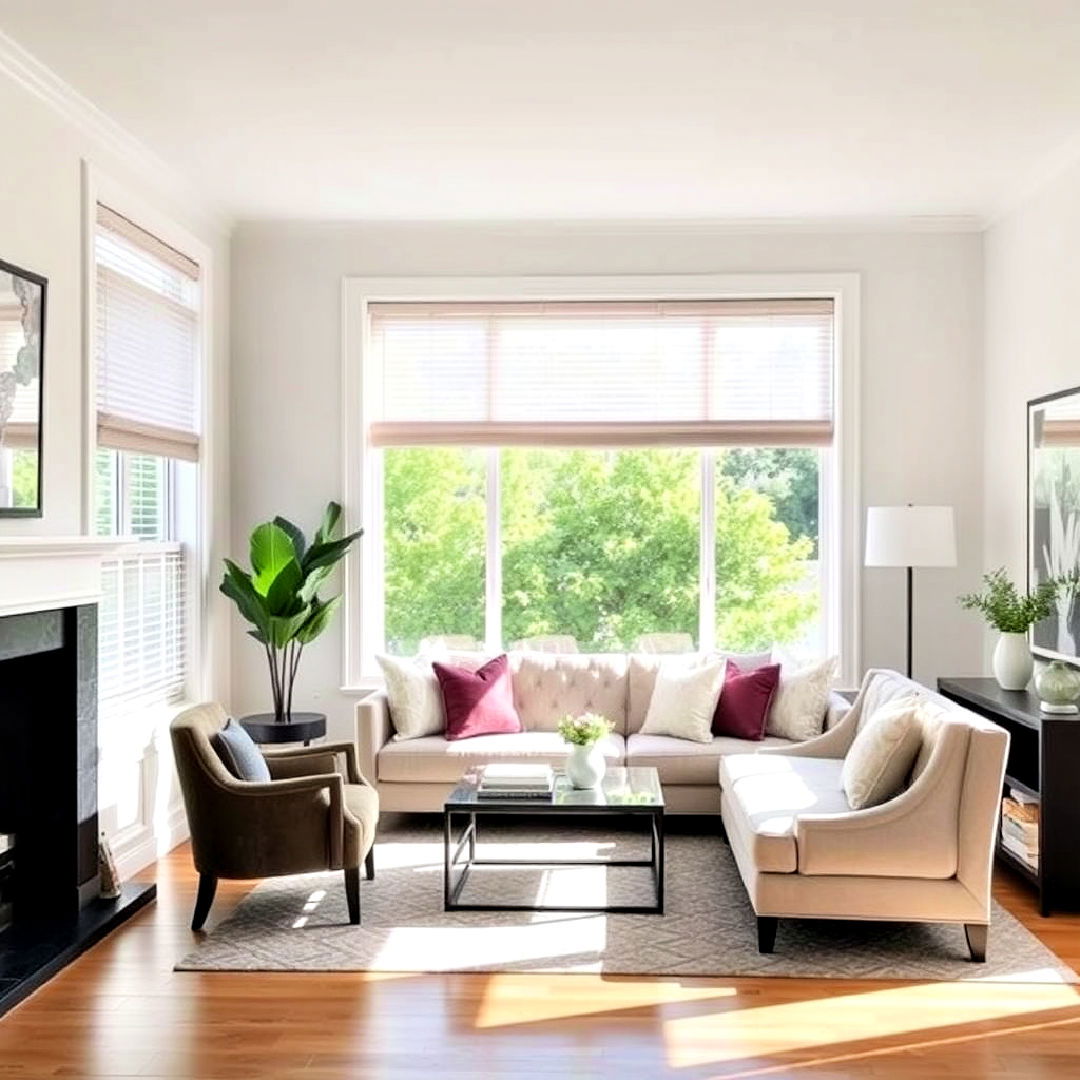
Maximize natural light by opting for minimal window treatments like sheer curtains or simple blinds. Allowing natural light to flood the room enhances its openness and brightness. Keeping window treatments understated ensures that the room feels airy and fresh, aligning with the clean, simple aesthetic of transitional design.
40. Decorate with Fresh Greenery
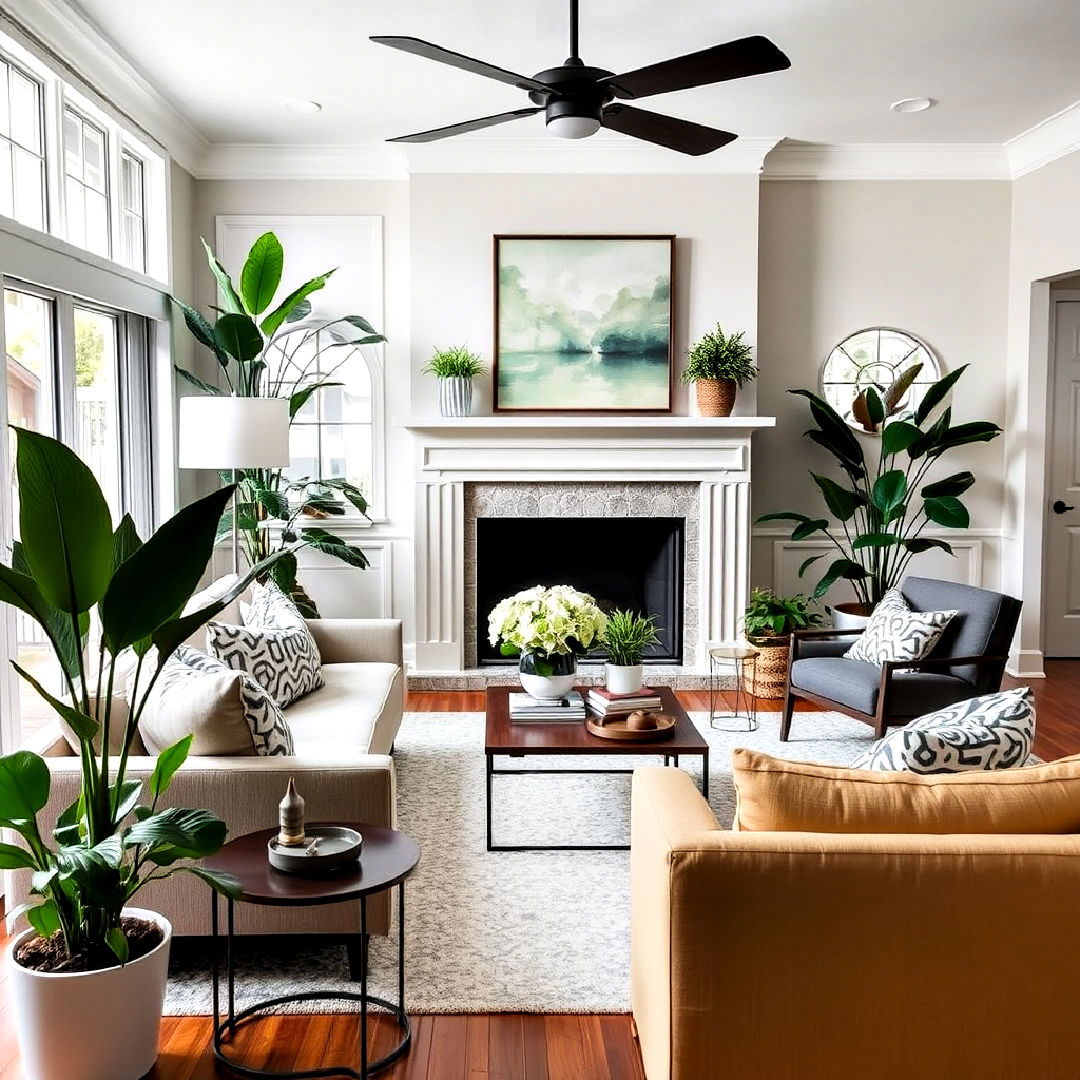
Incorporating fresh plants or greenery adds life and color to a transitional living room. Potted plants, large leafy greens, or even a vase of fresh flowers introduce a natural element that softens the space and makes it feel more inviting. Plants help balance the room’s clean lines with organic shapes, enhancing the overall harmony.
Conclusion:
Creating a transitional living room is about achieving harmony between classic charm and modern flair, making the space feel inviting and stylish. By carefully balancing textures, colors, and statement pieces, you can transform any living room into a beautifully curated space that radiates warmth and sophistication. Embrace a few key design elements—like neutral tones, layered textures, and statement accents—to make your living room a unique reflection of transitional style.
Key Points:
- Balance of Styles: Transitional living rooms combine modern and traditional elements, creating a harmonious, inviting space.
- Neutral Palette with Bold Accents: Use neutral tones as a base, adding pops of color or bold accents for visual interest.
- Textural Layers: Integrate diverse textures—like plush upholstery, layered rugs, and textured fabrics—to add depth and dimension.
- Statement Pieces: Incorporate unique elements, such as oversized art, statement lighting, or bold furniture, to anchor the design.
- Natural and Soft Lighting: Use layered and subtle lighting, maximizing natural light where possible, for a warm ambiance.
- Functional and Open Layout: Opt for furniture that enhances flow, with multi-functional pieces for practicality and style.
What to Do Next:
- Assess Your Space: Determine the room's layout, natural lighting, and existing furniture to see what can be incorporated or updated.
- Choose a Color Palette: Select a neutral base and identify potential accent colors or materials.
- Plan Key Statement Pieces: Decide on one or two standout items, such as a fireplace, art piece, or lighting fixture, to enhance the room’s design.
- Layer Textures and Lighting: Add varied textures through fabrics and rugs and consider both ambient and task lighting.
- Add Final Touches: Incorporate greenery, minimal window treatments, or decorative elements that tie the theme together.

